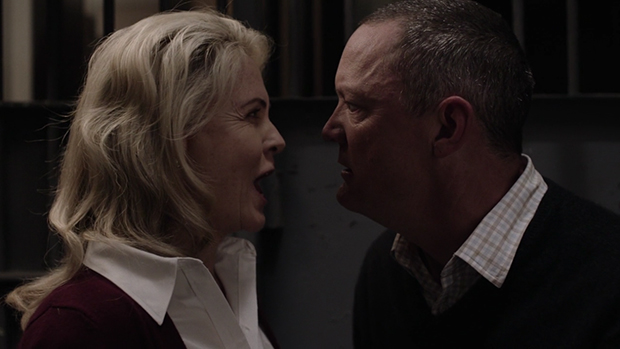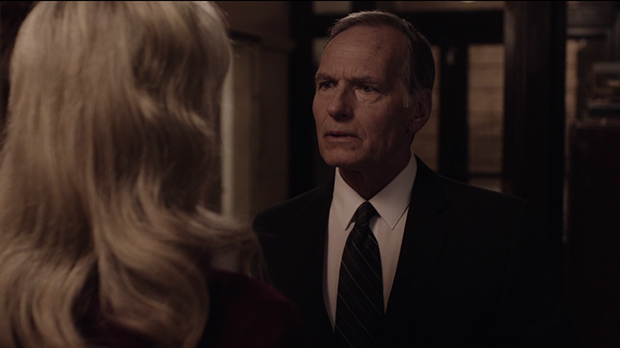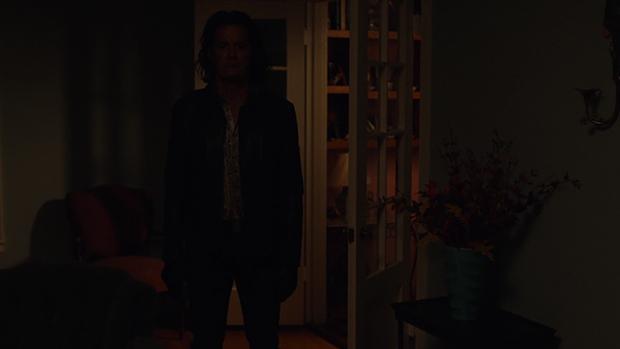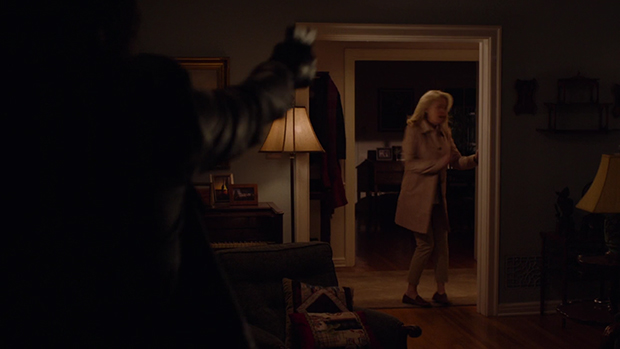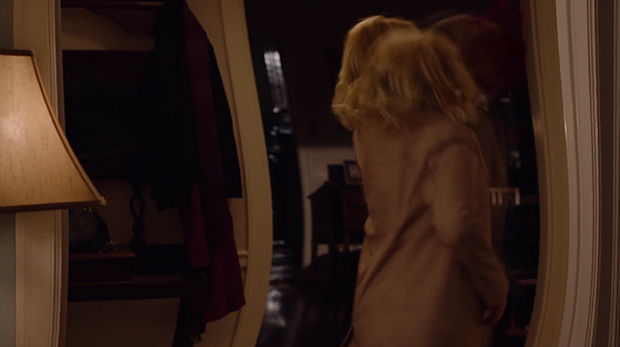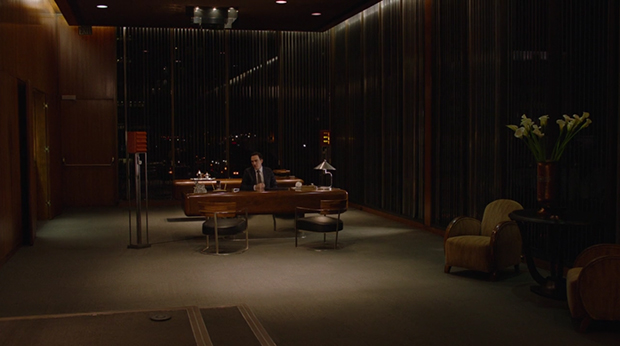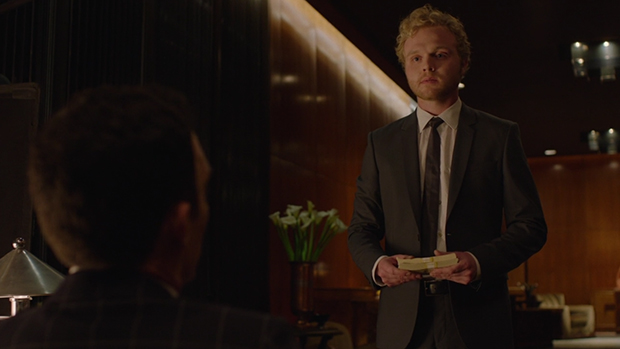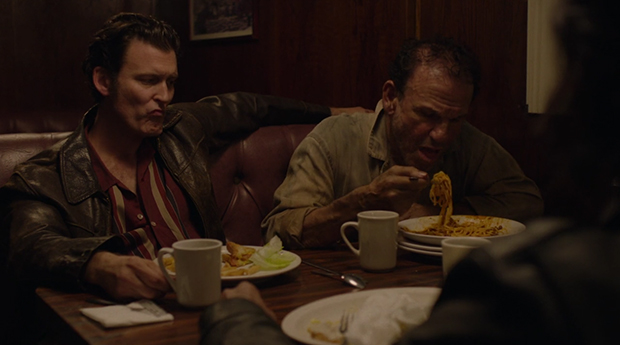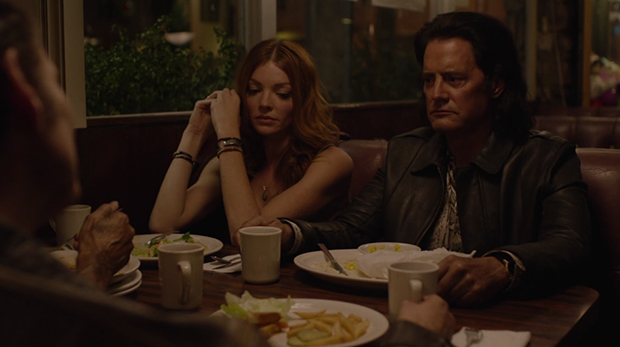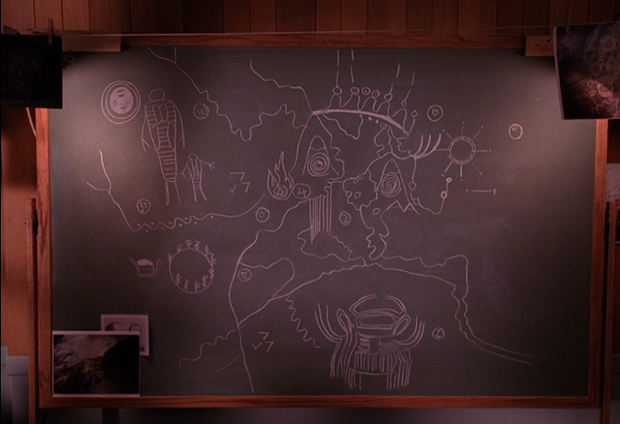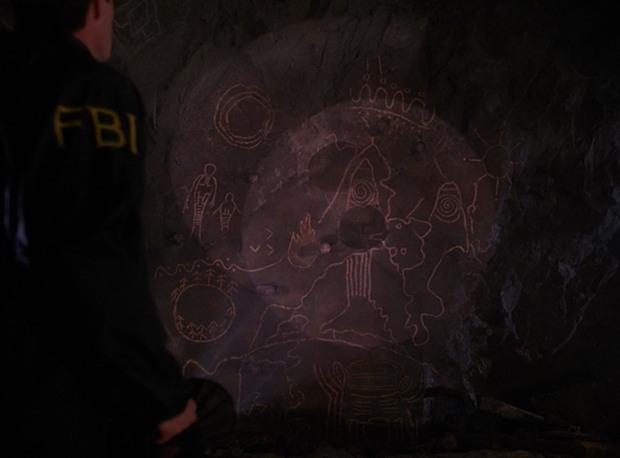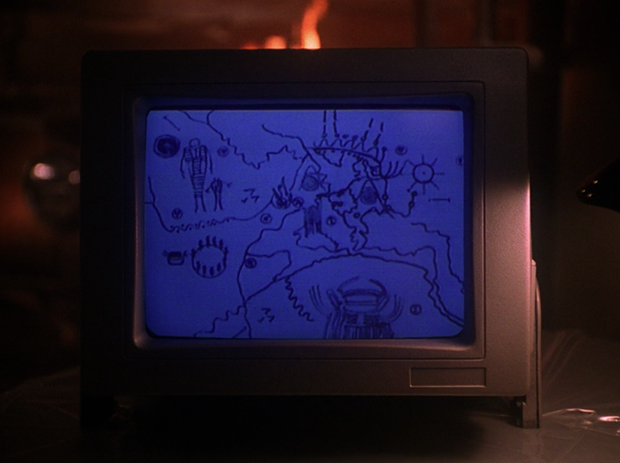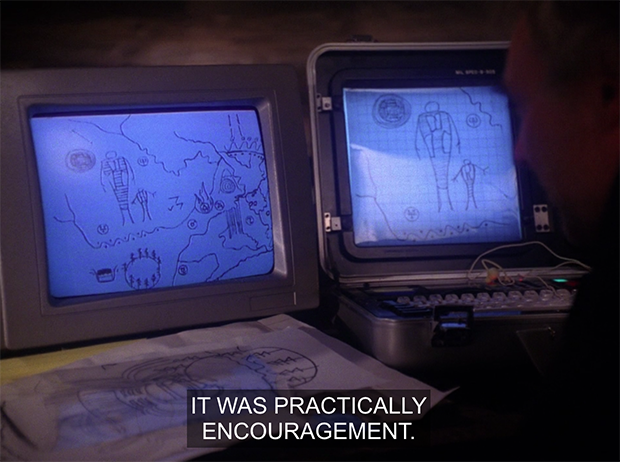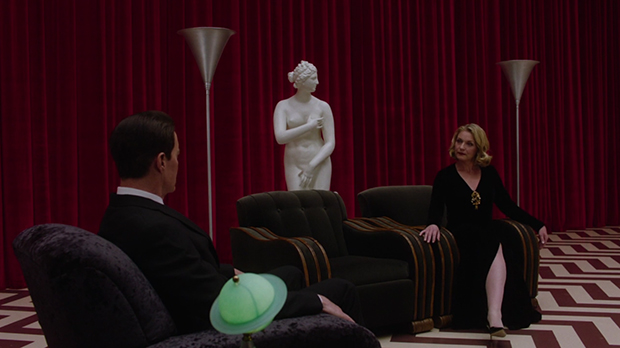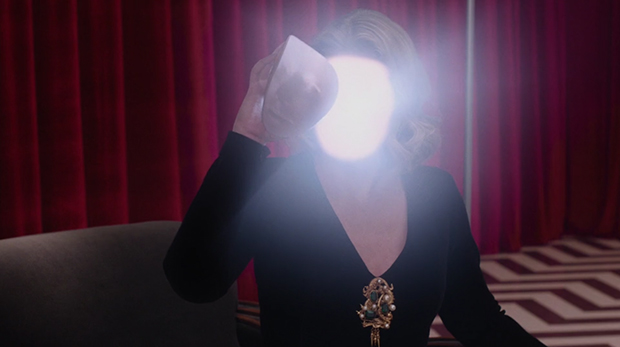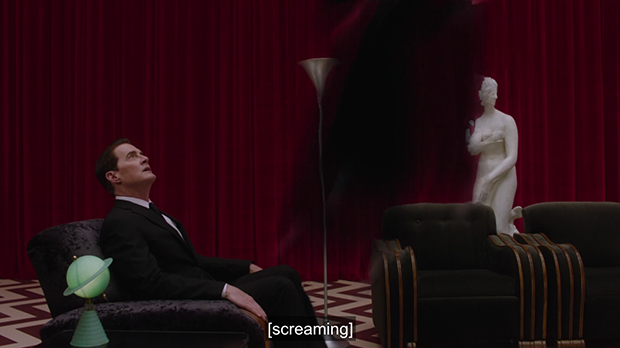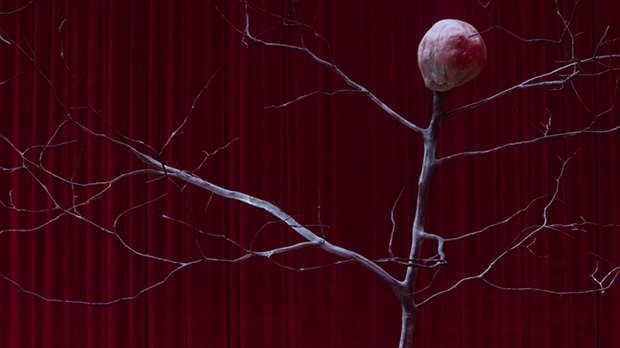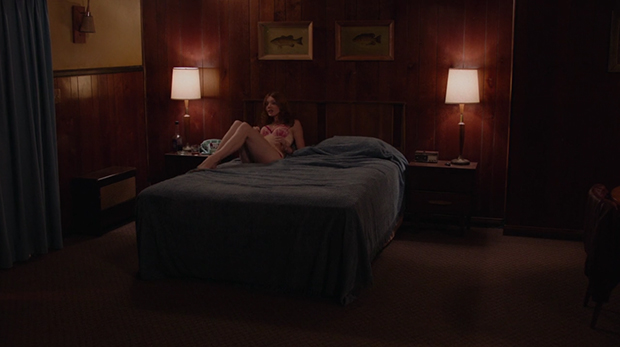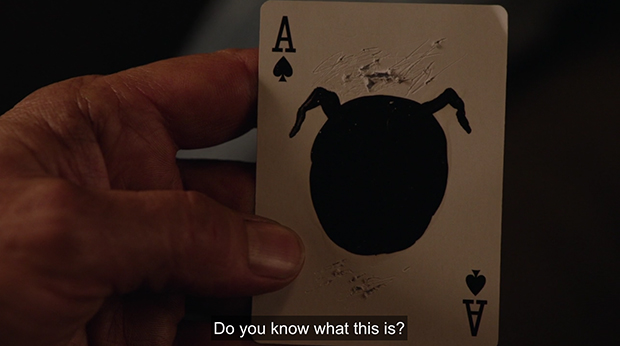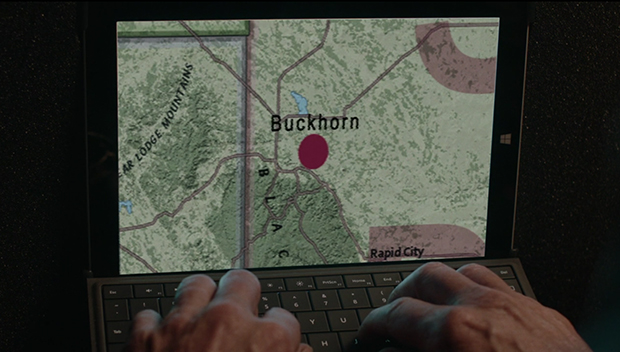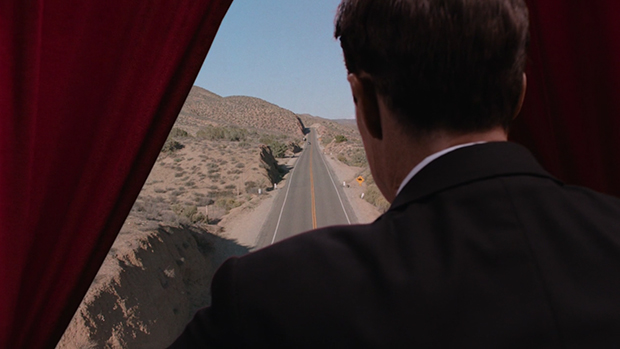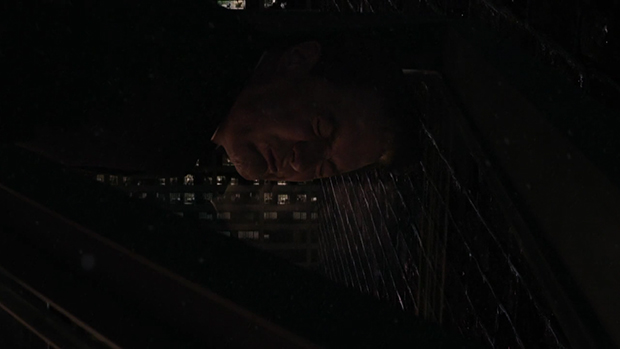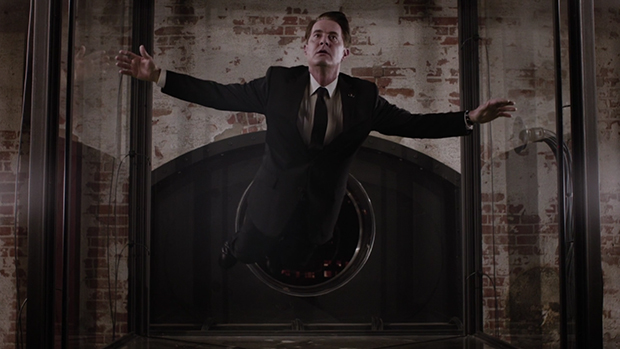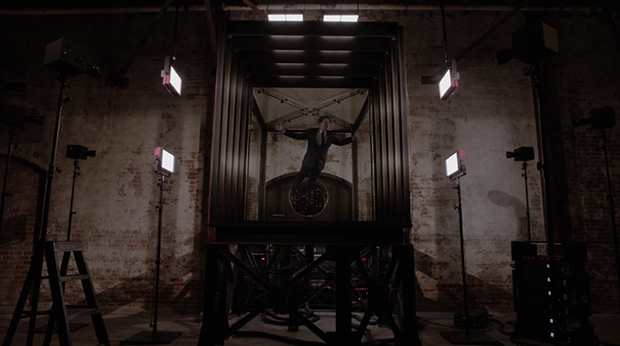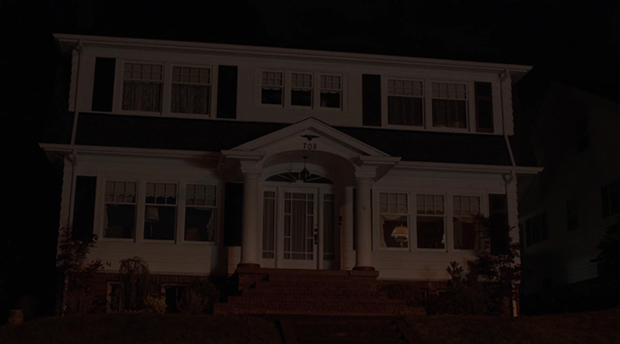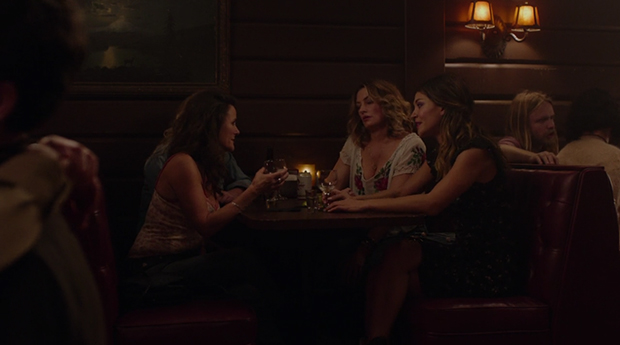TWIN PEAKS: THE RETURN

Go to Twin Peaks Table of Contents for a note on the analysis.
PART TWO
TOC and Supplemental Posts | Part 1 | Part 2 | Part 3 | Part 4 | Part 5 | Part 6 | Part 7 | Part 8 | Part 9 | Part 10 | Part 11 | Part 12 | Part 13 | Part 14 | Part 15 | Part 16 | Part 17 | Part 18 | Films Home
LINKS TO SECTIONS OF THE ANALYSIS ON THIS PAGE:
THE INTRO
PHYLLIS VISITS BILL HASTINGS IN JAIL - The faithlessness and rage behind the temperate gloss of the Hastings marriage / Themes of faithlessness / Dreamland / A dark phantom
YOU FOLLOW HUMAN NATURE PERFECTLY - Mr. C's association with Phyllis / Notes on Windom Earle and Cooper's affair with his wife / Seeming retributions for infidelity / About that left eye
LAS VEGAS, NEVADA, "TELL HER SHE HAS THE JOB" - The mirage / Duncan and the dream of the dark phantom in Mulholland Drive / Gender bending of the phantom in Mulholland Drive / The money in the black bag in Mulholland Drive compared to the money transaction in this scene / Elm in Mulholland Drive and Elm Street in The Return
I DON'T NEED ANYTHING - Repeating elements (the train, Jack's dinners, the message to Cooper) / Comparing Lynch/Frost repeating elements to Kubrick's repeating elements, such as his use of trains to represent repetitive cycles / Mr. C, Cooper, Audrey, and the question of need and want
HAWK VISITS GLASTONBURY GROVE: THE STARS TURN AND THE TIME PRESENTS ITSELF - On Glastonbury Grove
LAURA IS SNATCHED FROM THE RED ROOM - Venus, Saturn, Jupiter and the Red Room / The two Venuses of the Red Room / Repetition of the "Sometimes my arms bend back" scene / The repeating element of "Is it future or is it past?" / Comparing The-Tree-as-the-Arm with similar trees and the monster-child in Eraserhead / The shift of the floor in the Red Room from the original series / The FBI pin
THE MERCEDES HIDDEN - The humiliating massage of Jack's face / Recalibrating audience response to aggression
THE MURDER OF DARYA - What Mr. C wants / Repetition with slight differences / The peculiar circumstances of Ray landing in prison / Buckhorn's location / Let's talk about Phillip Jeffries / And Judy ? And who was actually speaking with Mr. C / Jeffries' reappearance in 1989 coincident with a splitting or doubling of Cooper's reality / Considering the meaning of the use of the Black Hills / Does Buckhorn leave any associative relationship with the Hornes and the Horne lodge
BEULAH, WYOMING
TIME AND TIME AGAIN - The implications of time and time again / The injunction to find Laura / The fragmented and beheaded Venus / The black horse / Non-existent
COOPER FALLS INTO THE GLASS BOX - Repeat of Tracey and Sam in New York / The misalignment of windows in a neighboring building perhaps connected with the doubling and misalignment we had observed in the Red Room / The glass box envisioned as an eye in this scene / The zigzags on the floor of the Red Room and the waterfall -- Comparing this scene to Henry's dream in Eraserhead / The starry effect compared to the particulates of Henry's brain
SARAH PALMER - Difference between the Palmer living room when observed from the inside as opposed to the street view, the lights in the windows not the same / The detritus of a lifetime of agony / Multiple reflections of violence / Meditation on human violence / The rationale of the killing of the water buffalo being followed by the scene at the Roadhouse
THE BANG BANG BAR - Colonial beer and the lions / Chrome vision
ON BEING AND EMPTINESS AND LYNCH AND METAMORPHOSIS
STAB AT A TIMELINE
THE INTRO
With the second part we have the full new Twin Peaks intro. Reviving the robin at the end of Blue Velvet, the old intro had begun with a bird on a branch, steam rising from the working saw mill, sparks flying as the blades of circular saws are machine sharpened, the welcome sign to Twin Peaks on the outskirts of town beside the river, a distant view of the falls cascading down from below the Great Northern Lodge, ending with trees reflected in a river tinted enough with red so that we might unconsciously see in it the folds of the Red Room's draperies. The new intro restates and revivifies a few of the resonating ideas associated with Twin Peaks that were never in the old intro. It entirely dissociates from the logging town setting, and instead focuses on Laura, scenic landscapes, the Great Northern and its falls, the red curtains and the zigzag flooring. (1) Laura's Homecoming Queen face fades in, her left eye generally oriented to be within a rainbow sphere that overlays an aerial view of clouds over a misty forest, (2) a 2nd shot of the forest on a high mountain ridge as the camera zooms in on it, begin credits with the theme "Falling" playing, (3) crossfade to the river by the Great Northern lodge leading to the boulder that separates the waters into twin falls that cascade down away from us as they reunite, (4), the falls transitioning to an image of the red curtains, rippling flame-like, (5), the curtains crossfading into and blending with with the spiraling zigzag floor of the Red Room.
PHYLLIS VISITS BILL HASTINGS IN JAIL
THE FAITHLESSNESS AND RAGE BEHIND THE TEMPERATE GLOSS OF THE HASTINGS MARRIAGE / DREAMLAND / A DARK PHANTOM
(1) About 1:39. We don't
return to Twin Peaks but carry on the story, from part one, of
Bill Hastings in Buckhorn, whose fingerprints were found all over the
apartment of the murdered Ruth Davenport. We have a close-up of Bill in his jail cell,
rubbing his head, anxious. A low rumbling sound accompanies that stops
with the sound of keys, and we see beyond him, through the bars, Phyllis
being shown into the jail cell area by their friend, Detective Dave.
(2) Phyllis and Dave from the exterior of
Bill's cell. She wears the same dark burgundy sweater, white shirt, and
khaki trousers as in part one. Dave unlocks Bill's cell. (3) Dave and Phyllis. Dave says, "Now, I can only give you a short visit." (4) Shot of Bill from outside the cell. Bill thanks
him. Dave locks Phyllis in and the pair sit and wait for Dave to exit
before they speak.
(5) Phyllis and
Bill in profile.
PHYLLIS: George says they're not
going to let you out on bail.
BILL: I'm, I'm in so much trouble. I
have, I have to tell you something. I wasn't there, but I had, I had a
dream that night, that, that I was in her apartment.
PHYLLIS: You
were there. Your fingerprints are there.
BILL: No, I swear to you, I
wasn't there. I swear to you, it was a dream.
PHYLLIS: Fuck you! You
fucking bastard! I've known about this affair. I've known about this
affair all along.
BILL (a low hum begins): Now you lookee here. I
know about you and George, and maybe somebody else, too!
PHYLLIS
(as, beyond, we see Dave returning): You're going down. Life in prison,
Bill. Life in prison.
Bill's insistence that he'd been in Ruth's apartment returns us to the
book Dreamland on a shelf in Ruth's bookcase.
We might have had our doubts already about Phyllis, because she seemed as if she was well aware the detectives would find something in Bill's car, so it seemed she had a hand in setting him up, but the fact remains that, for the viewer, her persona undergoes a metamorphosis here into something entirely different than what she's been presenting. She hasn't been overly sympathetic, but out of sight of Dave she transforms into a woman who viciously hates her husband and wants him locked away in prison for life whether he's guilty or not of Ruth's murder. We certainly have the feeling she knows much more than what she's letting on, meaning she may know, yes, that Bill's fingerprints are all over Ruth's apartment, but also that he is innocent. As for Bill, though we may be circumspect of him due Leland's metamorphosis from good to bad guy, he presents a largely sympathetic character by virtue of his seeming innocent angst, but then in the company of Phyllis he too transforms in response to her. It takes only a moment for the dialogue between the two to become
fraught with rage, Phyllis already hostile, Bill at first desparate,
then as Bill rallies in rage against Phyllis, telling her he knows about
George, a low hum sound builds to an ominous harsh tone with the
revelation of infidelities, the tone diminishing as Dave appears again and lets
Phyllis out. The quality of bared teeth anger engaged in by the two might remind of the pilot
of Twin Peaks, when James Hurley was put in jail on suspicion
for the killing of his secret girlfriend, Laura Palmer. Bobby Briggs,
Laura's public boyfriend, and his friend, Mike Nelson, are also in jail
for a fight at the roadhouse earlier that night. Seeing James, thinking
he is responsible for Laura's death, the two bark in primal monkey aggression
at him, taunting. We have here the same primal contempt. Then, as Phyllis
leaves Bill's cell, she turns to him and smiles with vengeful glee at
the prospect of his spending life in prison. He stares at her in
horrified disbelief, and perhaps the impact of the threat of a life in
prison only fully now descends upon him.
Some great acting between these two, just amazing chemistry.
(6) Phyllis leaving the jail cell. She
smiles. "Goodbye, Bill.
(7) Close-up of Bill, horrified by Phyllis' smile. (8) Dave shuts the jail cell door. (9) Close-up of Bill panicking. We see Dave and
Phyllis exit beyond. "Oh, my god, oh my, oh my god,
oh my god," Bill says. Again, as at the opening, he puts his head
in his hands, the low anxious rumbling beginning again.
They have each lived with one another's secret infidelities and said nothing. Now the the mutual peace contract is annulled and Phyllis is beyond ready to move on.
(10) Cut to an officer
drinking coffee in a hall and phones distantly ringing. Dave ushers
Phyllis into the hall (11) where we see a man
in a suit anxiously waiting.
(12) Phyllis
addresses him. PHYLLIS: George.
(13) GEORGE: Phyllis. How is
he?
(14) PHYLLIS: He knows.
(15) Cut to George.
(16) Back to
Phyllis. PHYLLIS: Don't walk me out.
(16) Back to George.
(17) Phyllis slyly grins. PHYLLIS: I'll see
you later at my place.
(18) George appears taken
aback by Phyllis' demeanor as she exits, as if this is not quite the
woman he's known, with whom he's been having an affair. (19) George, approaching Dave, asks, "How's he doing?" Dave says, "Well, he's uh, pretty shook up, I have to admit."
George asks, "And Phyllis?" Dave responds,
"She's had a really rough day, I believe."
George says, "Yes, I understand."
(20) Cut back to Bill in his jail cell, head
in hands. The camera tracks to the right past an empty cell then rests
upon the next cell in which sits an unknown man, sooty black all over,
face, hair, clothes. As Bill moans, "Oh, my god," the persistent
rumbling increasing, the body of the figure disappears, the head
separating and floating up.
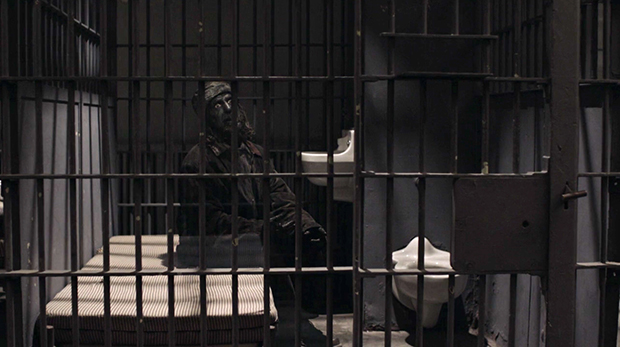
Jail Woodsman (image brightened to show
detail)
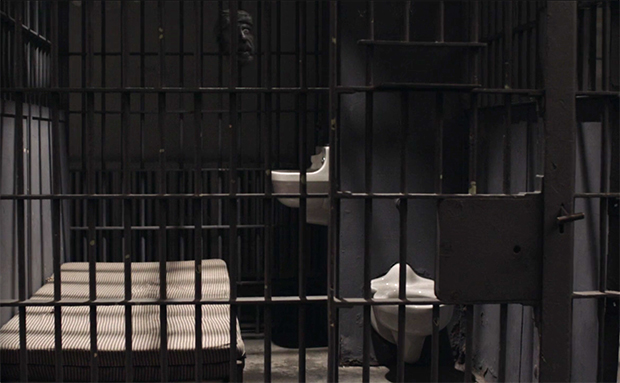
Jail Woodsman (image brightened to show
detail)
The dark man whose head floats away? Just in case you thought
Lynch/Frost might be crossing over into a more standard crime drama with
the manner in which these scenes with Phyllis and Bill, and Phyllis and
George, have been filmed--nope, that's not happening.
Even for the returning Twin
Peaks viewer, who expects the surreal and supernatural, the sooty
woodsman is something new, though the concept of the woodsman is not. The woodsman entities appeared in Fire Walk with Me in the
scene that Twin Peaks aficionados know as "the room above the
convenience store". Mysterious, their function unknown, they stood out
more as men in outrageous, fake-looking beards. They were not, as here,
sooty in appearance, as if having been themselves through fire. They
didn't strike as being particularly ominous, though if I entered a
roadhouse in a wooded part of Idaho and saw one I might turn around and
walk out. And I have been in such places.
This woodsman brings to mind a phantom in Mulholland
Drive, who I describe a couple of sections down in this analysis.
His presence assures that this will be no ordinary murder, not as if we
weren't already aware of this. The manner in which the head separates
from the body, as it ascends and disappears, reminds us of the peculiar
nature of the killings. Ruth Davenport's head is all that remains of
Ruth at the moment, found resting above the body of a man who is
unidentified but is likely Major Briggs. And Briggs' head is
missing.
At the end of this part, we will search the credits in vain for this
man. Twinpeaks.wikia.com states that it is Stewart Strauss, who will not
be credited until part 8.
YOU FOLLOW HUMAN NATURE PERFECTLY
Mr. C'S ASSOCIATION WITH PHYLLIS / NOTES ON WINDOM EARLE AND COOPER'S AFFAIR WITH HIS WIFE / SEEMING RETRIBUTIONS FOR INFIDELITY / ABOUT THAT LEFT EYE / PHYLLIS AND LAURA PALMER
(1) 6:16. Cut to the exterior
of the Hastings home. It is night. A dog barks in the distance. (2) Then the interior. Our view is from what is
perhaps the living room looking into the hall. A floor lamp softly illuminates the scene. We
see a piano with photos atop it. Very normal, middle class--the piano,
the photos. We hear the low hum, as if there is everywhere the
inescapable whir of a great machine to which people have become so
accustomed that they no longer acknowledge its maddening presence. We
hear a door open and shut. The hall light is turned on. Phyllis enters
in a tan coat, seeming to have arrived home from the police station. She
turns and, her attention caught by something in the living room, she
reacts with a start, gasping. The dinner party with George and his wife
may not have happened but she has now an unexpected visitor.
(3) We are then shown Mr. C, standing at the
other end of the living room by open French doors. The room is so dark
he is barely distinguishable in the shadows. (4) The camera returning to Phyllis, she smiles.
PHYLLIS: What are you doing here?
(5) The camera zooms in on Mr. C.
MR. C: You did good. You follow human nature perfectly. (6) Phyllis from beyond Mr. C's right shoulder. MR: C: This is George's gun.
(7) Mr. C speaks mechanically, raising the gun.
(8) Phyllis looks quizzical. (9) Back to Mr. C as he points the weapon. (10) Phyllis gasps, turning to run. (11) Medium-shot of Mr. C. as he fires upon Phyllis.
(12) Back to Phyllis. The scene warps briefly
as the bullet hits her body then returns to normal as she falls to the
floor. (13) Emotionless, C throws down the gun
and exits. (14) Shot of Phyllis lying on the
floor. (15) A close-up of Phyllis, shot
through the left eye, blood spilling onto the carpet.
Well, that was abrupt! No more Phyllis!! Bam!
Action is certainly kept moving along and the more new characters, like
Phyllis, who are killed, the less new characters we have to worry about
getting in the way of older Twin Peaks plots. That's one
way of looking at it.
Ruth Davenport's left eye had been shot out as well, so we wonder if we
are being shown that Mr. C was responsible also for her murder. The method of Phyllis'
murder seems to fulfill the function of informing us of the likely
suspect.
The viewer had been aware, due the previous scene, that
Bill knew Phyllis was having an affair with George, the lawyer, and
"maybe somebody else, too". The viewer would have wondered who that was, and may indeed have suspected it could possibly be Mr. C, considering the otherworldliness of the events and Phyllis' attitude.
Now we know who, with the manner in which Phyllis smiled upon realizing
it was C in her living room. She may not have been expecting him but
upon recognizing him she was comfortable with him. Welcoming of him.
Glad in the surprise of his being there. The viewer is then informed
that C is framing the lawyer for the murder, as he shoots Phyllis with
the gun.
We know these things. And now, if the viewer had
believed Beulla's place was in Twin Peaks, they likely realize, or must
assume that Buella's was instead near Buckhorn, South Dakota. If the
viewer reasons that Mr. C killed Phyllis and Ruth, and that Bill
Hastings has been framed, just as George is now being framed, then the
question is why the effort put into framing Bill and George? Why is Mr. C in South Dakota doing this?
In Buckhorn, the two women
murdered had been having affairs with married men. Bill and George had
both been having affairs as well, but they are not killed. Instead, they
are framed and if the truth of the framing is not discovered they will
spend the rest of their lives in prison, incarcerated for crimes they
can't prove they didn't commit. We will not debate which is worse--to
die immediately as these women have, or to endure the agony of rotting
away behind bars, innocent of murder, but guilty of having had an affair
with the murdered.
The viewer must question why C told Phyllis that "you follow human
nature perfectly". As he told her that "she did good", we may assume
that Phyllis knew that Bill was to be framed for the murder of Ruth and
had playacted surprise well for the police. For all that we know, Phyllis may have hidden
the flesh in Bill's car. More likely, she had been aware Mr. C had hidden
it there. We already had reason to wonder what she knew by reason of the
way she watched the officers as they searched Bill's car.
How would he have known about how Phyllis had acted had he not not somehow a way to have been watching her, or an informant. George? How else might he have come by George's gun? He must know George as well and so had known of George's gun and stolen it from him? Wait, we remember the shadow woodsman at the jail, and wonder if that spirit had been a conduit of information for C. Still, that doesn't answer how C came into possession of George's gun; they still might have known one another as well.
We know, in the original series, that Windom Earle (who I thought was a bore), a former partner of
Agent Cooper's, had gone ruthlessly mad, been institutionalized, and
escaped. It was the saga of Windom, he showing up in Twin Peaks to exact
vengeance on Cooper, who'd had an affair with Windom's wife, Caroline. Windom
had killed Caroline and attempted to kill Cooper, his
institutionalization following this. In Twin Peaks he arranged it so
that Cooper must enter the Red Room physically in order to rescue his
girlfriend, Annie, Windom having kidnapped her there. At one point, in
the Red Room, Dale had seen himself lying on the ground, bleeding from
the gut, a dead woman lying beside him. Astonished, believing it was
Caroline, he had called out her name. Annie had raised herself up
instead. She said that she had seen the face
of the man who murdered her, and it was her husband. Yet Annie was
unmarried. When Cooper called her Annie, Caroline appeared instead, to
be replaced again with Annie who said she was alive, then in Annie's stead appeared a
screaming Laura who is replaced with Windom Earle. Who was who? What was Cooper actually seeing? Maddy,
Laura's dead cousin (also killed by Leland) had earlier appeared and
told Cooper to beware her "cousin". Windom told Cooper that if he gave
him his soul then he would let Annie live, and Cooper accepted the
contract. At this point, BOB had unexpectedly intervened and said that
Windom was wrong, he couldn't ask for Cooper's soul, and that he would
now take Windom's soul. He told Cooper to go. BOB took Windom's soul
and Cooper ran off. Cooper's doppelganger then made his appearance,
rushing up to stand beside BOB and the empty vessel of Earle. BOB and he
laughed maniacally. The doppelganger pursued Cooper and caught him, thus
leaving the Red Room in place of Cooper. But the doppel didn't exit alone, he
took BOB along with him, as part of him, and BOB contains Windom's soul.
Frost's The Autobiography of F. B. I. Special Agent Dale Cooper: My
Life, My Tapes, written before the Laura Palmer case, sets out the
history of Windom Earle, Caroline and Cooper more thoroughly than in the
series. We learn from it that Caroline
had been kidnapped and forced into prostitution and a heroin
addiction. When she was rescued and moved to a safe house, Cooper had befriended her. Her husband absent, she vulnerable and needing support, Caroline and Cooper fell in love and had an affair. They were attacked and Cooper had
woken to find himself wounded and Caroline dead in his arms. Gordon
Cole, Cooper's superior in the FBI, had told Cooper that Windom had
found them and had been driven to madness by the death of his wife and
the fact his best friend had betrayed him. Cooper later learned that
Windom was already insane and had been responsible for murdering his
wife and stabbing him. His belief was that Windom had fostered the love
between Caroline and himself so that Windom could kill it.
Lynch,
reportedly, was not fond of the Windom Earle character, and though he
had to contend with it in the final episode of the original series,
Windom didn't appear in Fire Walk With Me. Still, I find
peculiar the focus on infidelity at the beginning of The
Return. Almost immediately in part one we had Jacoby exiting his
trailer and calling out, "Hey, Joe", which I noted was a possible
allusion to the song about a man who kills his faithless wife and heads
to Mexico. Part two opens with Bill and Phyllis bitterly revealing to
one another their awareness of one another's infidelities.
If the viewer knows the Windom history, they might conjecture that
Windom's soul, possessed by Bob, and Bob being a part of the
doppelganger, is carrying out vengeance on women who have affairs by
killing them, as Windom had done with Caroline, and framing the men with
whom they have had an affair, making them suffer the blame for the death of a loved one, or at least their sexual partner in betrayal. Or perhaps this is only a peculiar feature
of BOB's or the doppel's. We don't have enough information to do anything but speculate, but it does seem that betrayal is being emphasized.
We don't know why Ruth, Phyllis, Bill
and George. We don't know why now. We don't know why Ruth's body was
replaced with that of a man's. It may be that Mr. C only told Phyllis
she followed human nature perfectly because he is not himself completely
human, being a doppelganger, and was only acknowledging that she behaved
as humanly expected, but as we know C is a doppel we also wonder if
Phyllis could be one. These are all questions the viewer is invited
to raise.
Another thing to be considered in respect of the seeming retribution for infidelities, is the left eye being shot out, just as Nadine's eye was accidentally shot out by Ed. In the original series, the story was that despite Norma and Ed being in love and expected to marry, Norma and Hank ran off for a weekend, and jealous Ed stumbled upon Nadine, who was infatuated with him, and married her. He immediately found out that Norma hadn't even slept with Hank. On his honeymoon with Nadine, wanting to get back with Norma, Ed had planned to talk to Nadine about annulment. Before he got around to it, they went hunting. He had made two kills. He enjoyed the sound of the gun and wanted to continue. When he shot again the bullet hit a rock and ricocheted into Nadine's eye. He stayed together with her out of pity, and guilt.
In The Secret History, Hawk is given as having written a true account of the romance of Ed and Norma--which is in itself curious, that he would write this and that it would be left in the Bookhouse for anyone to find. I don't get that at all. As he relates it, while Ed was in Vietnam, Hank romanced Norma and hid Ed's letters to her. Believing Ed was no longer interested in her, she married Hank. When Ed returned, he married Nadine. Nadine began to suspect Ed was in love with Norma and was jealous. When he went hunting with Harry Truman, Nadine followed, believing he was going to meet Norma. She startled some ducks, he took aim at them, not knowing she was there, fired, and that was when he accidentally shot out her eye.
Treating her psychologically, believing that nothing happens by accident, Jacoby reasoned that perhaps unconsciously Nadine had chosen to be shot. A part of his report from The Secret History is below.
The left eye is the right side of the brain so--in the event a choice was made--patient has chosen to shut down the optic pathway to her intuitive side. One possible interpretation would be that she was sensing something getting on around her that she didn't want to see...
Patient would have been a perfect candidate to test my new optical integration system. Glasses with one red polarized lens for the right eye, one blue polarized lens for the left. My working theory being that the red spectrum slightly suppresses activity in the left or logical hemisphere, while the blue spectrum does the same to the spatial-intuitive side of the brain and that when worn together--although it does tend to give "reality" a purple tint--the patient tends to experience increased integration between the two sides to work together...
Again, with Ed and Nadine we're looking at another story of faithlessness, or confusion in love, that costs Nadine her left eye, either on her honeymoon or because she got mixed up with some ducks. In Ruth's apartment there had been a duck decoy, so I don't think it's stretching it to make the association between Ruth and Nadine.
I still have the lingering feeling that Phyllis is a possible version of
what would have been Laura, had she lived. I'm amused that she's played by Cornelia Guest, a socialite who was "Debutante of the Decade" in the 80s, and I'm further amused that with the names Phyllis and George (her lawyer lover) we get Phyllis George, who was a beauty queen, Miss Texas of 197 and Miss America of 1971. Had Laura somehow escaped catastrophe, had she not self-destructed due her past, one can sense how one path for her might have been the homecoming beauty tucked into the form of the middle class wife who can't quite contain all aspects of herself in that role, and has affair after affair with men like George (a lawyer, like Laura's father) and the blatantly dangerous Mr. C, who she might believe she can handle but she can't.
LAS VEGAS, NEVADA, "TELL HER SHE HAS THE JOB"
THE MIRAGE / DUNCAN AND THE DREAM OF THE DARK PHANTOM IN MULHOLLAND DRIVE / GENDER BENDING OF THE PHANTOM IN MULHOLLAND DRIVE / THE MONEY IN THE BLACK BAG IN MULHOLLAND DRIVE COMPARED TO THE MONEY TRANSACTION IN THIS SCENE / ELM IN MULHOLLAND DRIVE AND ELM STREET IN THE RETURN
(1) 7:18. We go now to an
establishing shot of Las Vegas, Nevada, yet another location,
unexpected. We see, most prominently, The Mirage hotel. The sounds of
soft jazz. It seems likely we should pay note to our being able to see The Mirage. Las Vegas makes its living off mirage aspects, the dream promise that overlays the gritty reality. (2) Then no music as we are shown a
large, modern, sophisticated office in which there is a vase filled
with tall, white lilies, a flower often associated with death. At the desk is Duncan Todd (Patrick Fischler).
Over the intercom, he calls Roger (Joe Adler) into his office. "Roger, come in here." (3)
Roger promptly, enters.
(4) Duncan
takes from a drawer two sheafs of bills and hands them to him.
DUNCAN: Tell her she has the job.
(5) ROGER: Mr. Todd?
(6) DUNCAN: Yes,
Roger?
(7)
ROGER: Can I ask you a question?
(8)
DUNCAN: Go ahead.
(0) ROGER: Why do you let him
make you do these things.
(10) DUNCAN (smiling): Roger, you better hope that you never
get involved with someone like him. (11) Shot of Roger. (12)
DUNCAN: Never have someone like him in your
life.
(13) Unquestioning, Roger
exits.
Patrick Fischler was also in Mulholland Drive,
playing an enigmatic character named Dan. I'm assuming that one reason
we might have him here, appearing within a couple of scenes of the dark
phantom two cells down from Bill, is due his connection with a dark,
sinister character in Mulholland Drive.
In Mulholland Drive, Dan meets a man named Herb at a diner,
Winkie's, telling him he'd had two dreams about the place. He is
terrified. He tells Herb, "It's the second one I've had, but they were
both the same. They start out that I'm in here but it's not day or
night. It's kinda half night, but it looks just like this except for the
light, and I'm scared like I can't tell ya. Of all people, you're
standing right over there by that counter. You're in both dreams and
you're scared. I get even more frightened when I see how afraid you are
and then I realize what it is. There's a man in back of this place.
He's the one...he's the one who's doing it. I can see him through the
wall. I can see his face. I hope I never see that face ever outside a
dream."
Herb encourages Dan to go outside and face what he
anticipates, his fears. Though it's not spoken we know that Herb expects Dan to find nothing in back and thusly he will realize his fear was
pointless. Nothing is there, it's all in his mind. Instead, a sooty
faced apparition confronts him, obviously not seen by Herb, and Dan
falls to the ground in a faint. Such is the strength of this mirage.
In other words, the anxieties of the mind and dreams are real,
is what Lynch seems to be saying, at least in respect of the affected characters. The phantom may not be physical, but it still has
energy and potency. We also have a bit of this read in The
Return, when we see the phantom in the cell block, that Bill's torment, his anguish, might be
represented in the phantom.
Though Dan states there is "a man"
in the back of the place, the phantom/homeless person is instead played
by a woman, but appears sexually ambiguous when she is viewed only
briefly.
Later in Mulholland Drive, we see a main character, Diane
Selwyn, at Winkie's arranging a hit on a woman with whom she had perhaps
been in love, by whom she may have been betrayed, who is now sexually involved with another, and of whom she is
also ferociously jealous. She gives the hit man some money in a black
bag. She sits in the same place as had Herb, and the hit man sits in the
place as had Dan. But Dan, who is only in the film twice, is also there.
He stands at the counter and looks at her. The hit man gives Diane an
ordinary blue key and tells her that when she sees this key in the place
he told her it would appear, she will know the job is done. She asks
what the key opens, and he laughs.
At the film's end, the
phantom individual appears again, presented as an otherwordly homeless
person. The individual holds a bag in which is placed a mysterious box,
a soda can key beside it. By association with the soda can key, the
implication is that this box is what the blue key opens, and we have
already earlier in the film seen a very different blue key open this
same box and that the person who opened it (upon whom the hit will be
ordered) disappeared. The blue box now in this bag, from the bag,
perhaps from the box, emerges an elderly, miniature couple. This same
elderly couple was with the main character upon her arrival
to Hollywood, coincidental traveling companions when her part was that of an idealistic and hopeful girl
named Betty Elm. They had wished her luck and looked forward to seeing
her on the silver screen one day. In contrast to the idealistic Betty's
story line, Diane Selwyn is a hardened and desperate individual who has
lost her dreams and descended into a world of drugs. The elderly couple,
released from the bag, appear to the despondent Diane and chase her
through her apartment, laughing. Pursued by unfulfilled promise, her broken dreams now demonic, she
screams, runs to her bedroom, grabs a gun and shoots herself. A mist
fills the room and in the mist we see the sooty-faced creature. One
interpretation is that Betty would seem what Diane had
wished she would be.
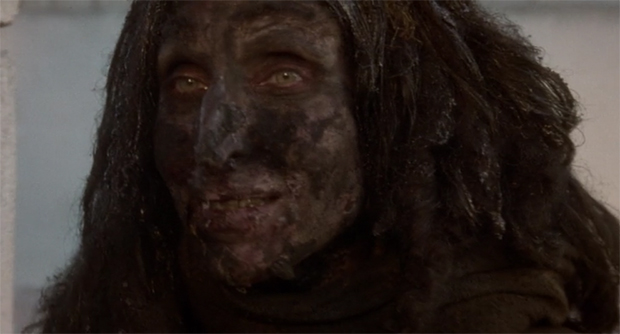
Sooty Character from Mulholland Drive
The reason I go into this, but will not get into an
interpretation, is that it is significant that Lynch has presented the
sooty individual in the prison with Bill, then two scenes later has a
scene involving an actor who in Mulholland Drive had been
confronted with a similar phantom. Not only that, but just as with the hit arranged at Winkie's, two sheafs of
money are involved, Duncan handing them over to Roger for
a girl who "has the job". Whoever it is who has "this job", as cash is
involved, we might assume is in Las Vegas as the cash
will likely be hand-delivered. The girl who has the job may also be a
hit "man", just as Diane had given money for a hit.
The phantom seems to be connected with the evil of this hit job, and it may be that it affects Dan even though he's not involved.
Following immediately after the scene of Mr. C killing Phyllis,
with Roger asking Duncan "why do you let him make you do these things",
and Duncan responding that Roger should hope such a person is never in
his life, the viewer may be led to assume that Mr. C is the man bossing
Duncan. We've already seen that Mr. C has luxury cars. We already may
assume Mr. C is even the billionaire who is behind the secretive
building and its glass box. It fits that he should have somehow made a
great deal of money and have a part of his life that presents perfect,
sophisticated luxury, but also that accompanying this is something darker, that he would also live
in cheap motels and associate with people who would be conspicuously out
of place in Duncan's office. The viewer does not know for certain
however, and so there is always maintained the tension of the question,
of never confidently knowing.
Note that the idealistic Betty, in Mulholland Drive, had the
last name of Elm, and that the Hastings live on Elm and Bill's secretary's name is Betty. A photo we had seen
in the Hastings home was of Kafka who wrote The Metamorphosis. The
confusion of metamorphosis in Mulholland Drive is such that
Betty Elm is also Diane Selwyn.
In the case of Duncan, taking for
granted that he is working for Mr. C, we must wonder how he met him,
just as we wonder how Phyllis met him.
Roger ought to get the hell out of there because if Todd is associated with C then he's too close for comfort.
I DON'T NEED ANYTHING
REPEATING ELEMENTS (THE TRAIN, JACK'S DINNERS, THE MESSAGE TO COOPER) / COMPARING LYNCH/FROST REPEATING ELEMENTS TO KUBRICK'S REPEATING ELEMENTS, SUCH AS HIS USE OF TRAINS TO REPRESENT REPETITIVE CYCLES / MR. C, COOPER, AUDREY AND THE QUESTION OF NEED AND WANT
(1) 9:02. Night. A train crossing. As the train passes we see BNSL on three leading engines.
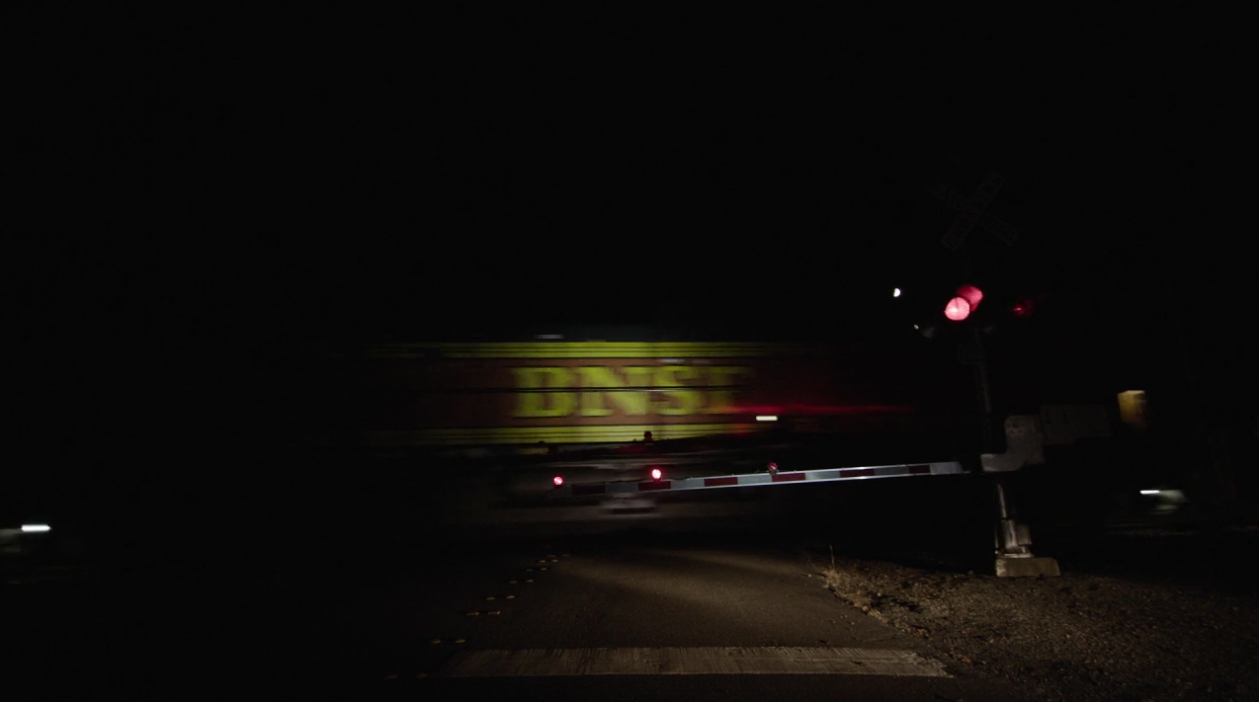
The train
(2) We then see the exterior
of a cheap motel--or what is classic Hollywood cheap.
(3) Cut to Ray and a new character named Jack (Steve
Baker) in a diner. The train rumbles in the distance as Jack mutely
eats. RAY (laughing): Jack, you barely touched your
three dinners.
(4) Mr. C looks,
with some severity, at the laughing Ray.
(5) RAY: Darya said something
about you being worried about tomorrow?
(6) Mr. C and Darya from beyond Ray's right
shoulder. RAY: Or the day after?
MR. C: I'm not
worried, Ray, about anything.
(7)
RAY: Well, that's good.
(8) MR. C: For a while, day after
tomorrow, I'll need to be on my own. That might be a good time for you
to learn how to mind your own business.
(9) RAY: Well, meantime, there's
anything I can do to help, just let me know.
(10) MR. C: I'll be sure to let
you know, Ray.
(11) RAY: And I'll follow up on that contact of mine...
(12) Mr. C. RAY:
...hopefully get the information you need.
MR. C: Want. Not need.
(13) Reaction shot of Ray.
(14) Return to Mr. C. MR.
C: I don't need anything, Ray.
(15) Ray.
(16) Return
to Mr. C. MR. C: If there's one thing you should
know about me, Ray, it's that I don't need anything. I want.
(17) Ray.
(18) Return to Mr. C. MR. C: And
I want that information.
(19)
Ray.
(20) Mr. C. MR.
C: Kind of funny that she'll only give it to you.
(21) Ray. RAY: This
information seems pretty important to you.
(22) Mr. C.
(23)
Ray.
RAY: Don't worry, I'll get it for
you.
MR. C: And I better be able to trust that
information.
(24) RAY: She's Hastings' secretary. She knows what he knows.
(25) Mr. C glares at Ray.
(26) Ray smiles back as the train's horn
blows.
(27) Mr. C. looks over to Darya,
examining the intimate expression she shares with Ray. Go to black.
Jack is a silent almost animal-like character who wolfs
down three meals, and that it is three meals seems significant following
our being shown three BNSL engines of the train passing by.
The
3x repetition may remind of the "Coma" episode in the original series.
At the Double R Diner, Margaret gave Major Briggs a message from her
log, telling him to "Deliver the message." Later he visited Cooper and
told him of his work, that it was with deep space monitors aimed at
distant galaxies looking for communications from other life forms in the
universe, and that two clear messages had come in. One, around the time
Cooper was shot, was that, "The owls are not what they seem." The other
was Cooper's name repeated several times. Though we see on the print-out
that Briggs shows Cooper that Cooper's name was repeated more than 3
times, the lasting impression for the viewer has become the message
being "Cooper Cooper Cooper". For Cooper, this message partly fulfilled
the Giant's prophecy that "The owls are not what they seem" would come
true. That night, Cooper dreams of an owl superimposed over Sarah's
vision of BOB.
The "Cooper Cooper Cooper" message, according to
The Secret History of Twin Peaks, was what would later lead
Briggs to believe that Cooper was the contact replacing Douglas
Milford, for which reason he asked to meet with him after Cooper's
return from the Red Room and realized that something was wrong.
With the train, I can't help but be reminded of how Kubrick uses trains
to symbolize/signal repetitive cycles, such as in Clockwork
Orange with the comic book of the photographer who finds himself
shooting something that happened many years before on a railroad track,
and in Eyes Wide Shut where we see in a newspaper the reports
on two separate violent instances on a train that occurred about the same time several years apart, creating a sense of deja vu for
people, and an individual interviewed pleads for the violence to stop. These reports form a frame around the
news article on the death of Mandy in which there are several repeated
sentences in the article, these repeats expressing the same idea of recycling as observed in the articles on the train. Things happening again so they are much the same but different. We have also the deja vu aspects in The Shining and the question of past interfering with and mixing with the present. I have, in my analyses on Kubrick, written in depth on these recyclings, which are somewhat related to Nietzsche's concept of the eternal return, allusions to which are had in 2001.
The question of need and want came up with Cooper when he found
Audrey in his bed in the original series. She'd asked if he didn't want
her and he'd replied that what a person wanted and needed were two
different things. He had then gone on to speak about a life style he was
expected to lead suitable to his being an FBI agent, upholding certain
ideals. So, Audrey might have been "wanted" but she was not what was "needed".
Doppelcoop is emphatic on making it clear that he needs nothing, he only
wants. Which sets Doppelcoop and Cooper apart. Mr. C operates according
to his wants. Cooper makes choices according to what he feels is ethical and needed.
We learn from this scene that Hastings' secretary, Betty, is in contact
with Ray and has information that Mr. C wants. We at least know now that
Mr. C had picked Darya and Ray up in connection with the Hastings
business. What information could that be and how did the secretary of a
school principal in Buckhorn, South Dakota come by something that Mr. C would want?
HAWK VISITS GLASTONBURY GROVE: THE STARS TURN AND THE TIME PRESENTS ITSELF
ON GLASTONBURY GROVE
(1) About 12:10. Dark, dark
night and the rustling of trees as in the scene in which Margaret and
Hawk made their first appearances in part one. (2) The light of a flashlight plays over leaves.
(3) We are shown the source light of the
flashlight but not who is holding it. (4) Then
cut back to the light on the leaves again as the person continues
through the forest. (5) Cut back to the source
of the light. (6) The light on the trees.
(7) Cut to Margaret, as in the scene
of her in part one, making a phone call. (8)
Cut back to the forest and we hear a cell phone ringing.
(9) Finally, we are shown who holds the flashlight.
It is Hawk. He takes out his phone and answers it.
HAWK: Margaret?
(10) MARGARET: Hawk.
Where are you walking tonight.
(11)
HAWK: Once again, your log and I are on the same
page. There's supposed to be something happening here
tonight.
(12)
MARGARET: The stars turn, and the time presents itself. Hawk, watch
carefully.
(13)
HAWK: I will, Margaret.
(14) MARGARET: I'm too weak to go with you, but stop by. I
have coffee and pie for you.
(15)
HAWK: Gonna have to be after. I'm almost there,
now.
(16)
MARGARET: Please, let me know what happens.
(17) HAWK: I will, Margaret.
Good night, Margaret
(18) Hawk
hangs up the phone and continues on, (19) his
flashlight shining on the branches of the trees. (20) Hawk looks as if he has found what he's looking
for. (21) It's Glastonbury Grove. (21) Hawk. (22) We hear
whooshing sounds as he points the light into the sycamores, and we seem
to see a subtle, ghostly layering of the red draperies of the Red Room
appearing. (23) Hawk looks up. (24) Again, the trees turn rust red.

The Log Lady
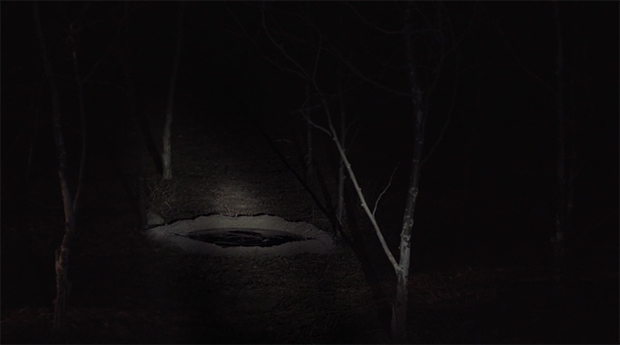
The Grove
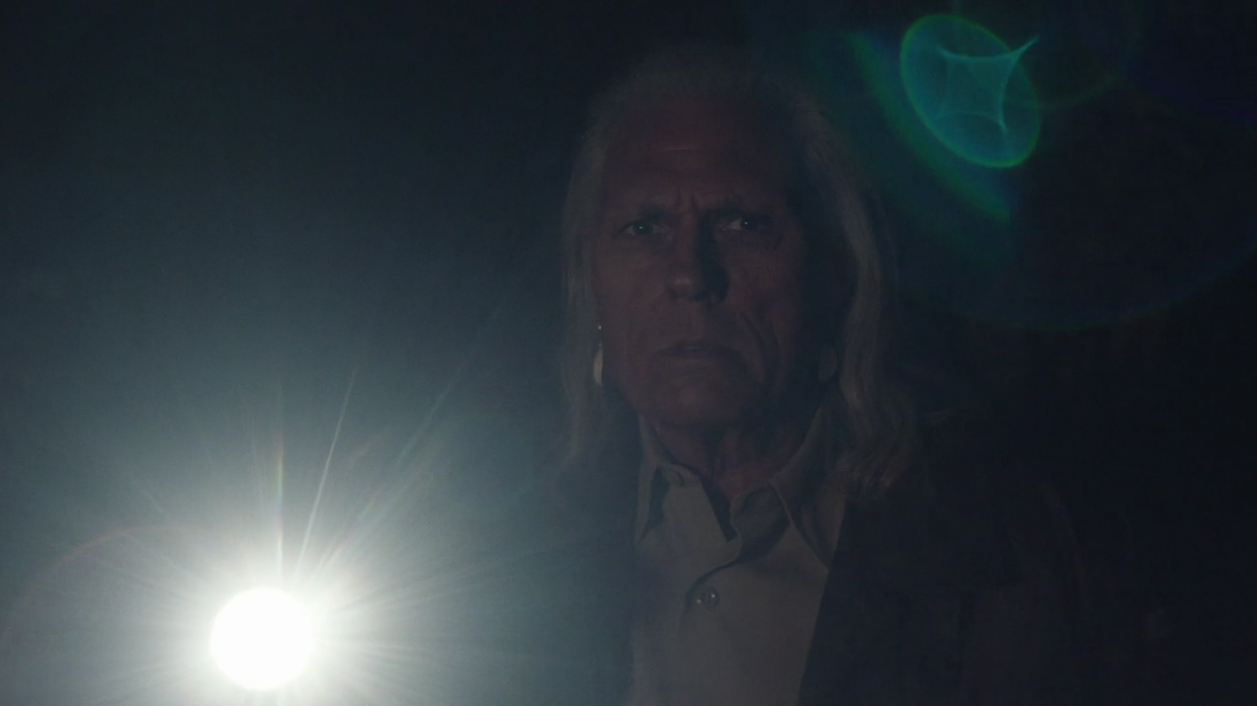
Hawk at the Grove
(25) Hawk points the light at
us, via the camera, his eyes looking directly into our own.
And
go to a bright white light. Then the Red Room.
How does Hawk
know that something is happening? And why does he look into the eyes of
the audience as a transition is made to the Red Room?
Glastonbury Grove, located in the fictional Ghostwood National Forest
near Twin Peaks, has come to be nearly as famed as the Red Room but was
a minimal presence in the original series, not seen until the end of
"The Path to the Black Lodge" episode as BOB stepped out of the other
dimension of the Red Room into the grove, and its name not mentioned
until the final episode. Owl Cave was instead a focus before this, and
it would seem that the discovery of a petroglyph map at Owl Cave, on
which symbols representing Glastonbury Grove are represented, was needed
before Glastonbury Grove itself could/would be introduced. Symbols on
the petroglyph were said, by Major Briggs, to show that when Saturn and
Jupiter are aligned the grove opens to the Black Lodge. This might
instead be a symbolic alignment, for entrances
and exits from the lodge at the grove have nothing to do with physical
planetary alignments.
Glastonbury Grove brings in legends of the
Holy Grail as well as King Arthur. The myth of Joseph of Arimathea
gives him as having carried with him the Holy Grail to the isle of
Avalon. Arriving on the isle, he thrust his staff in the ground and from
this staff sprang the Glastonbury Thorn. At the base of the Tor (a
hill), at the entrance to the underworld, he buried the Holy Grail. From this arose a spring called the Chalice Well that would grant eternal
youth to any who drank from it. King Arthur was given as being buried at
Glastonbury Abbey.
What is most notable is that at Glastonbury Tor was an entrance to the
underworld, which we have with Glastonbury Grove being an entrance to The Red Room/Black Lodge.
We see figures on the map that seem to represent the
Giant (or ???????) and the short man known as The Man from Another
Place, who is also The Arm. The sycamore grove is said to have twelve
trees but we see only eleven in this rendering that was done by Andy. We see the twin peaks of the neighboring mountains and that within them
are whorls that typically represent infinity. What looks like a compass
sign on the right reminds of the neon above Big Ed Hurley's gas station
but in that sign are rays emanating from a seeming goose egg, as in the goose that laid the golden egg.
Windom Earle's maps on his computers are like Andy's, showing 11 rather than 12 trees, and there are other differences from the map in the cave, such as both Andy's map and Earle's have a different placement of the globe in relationship to the giant and short figures, and the number of mountain shapes on the right side of the map beside what seems to be a sun. One wonders if we are to take it that one is unable to draw an exact replica.
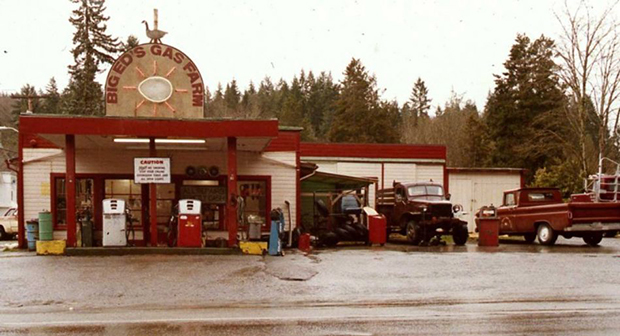
Big Ed's Gas Farm
At the bottom of the map is a glyph that appears almost
insectoid with pincers. Blue Velvet began with the beautiful mirage of Lumberton being pulled back to show the stag beetles with their pincers feeding or warring below the surface of the green blanket of grass.
This "map" is peculiar with the placement of Glastonbury Grove before, and at a distance from, White Tail Mountain, when other maps give Glastonbury in the Ghostwood Forest to the east of Twin Peaks and Blue Pine Mountain. We even seem to observe the White Tail falls, by the Great Northern, between Glastonbury Grove and White Tail Mountain, and the sign for Jupiter seemingly associated with them.
Several other maps of the area are below:
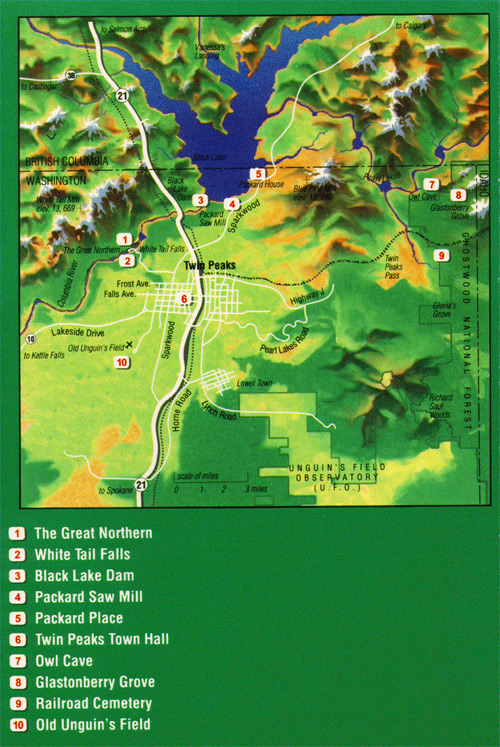
Twin Peaks map from 1991 David Lynch book
from welcometotwinpeaks.com
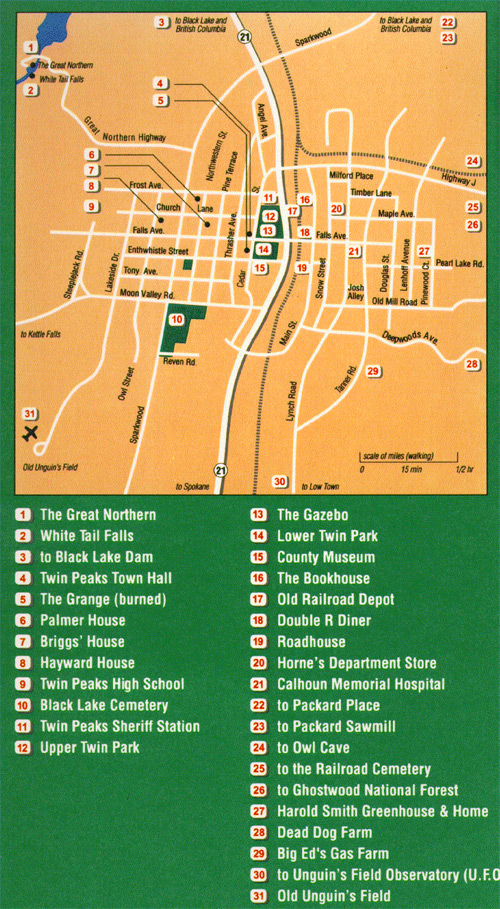
Twin Peaks map from 1991 David Lynch book
from welcometotwinpeaks.com
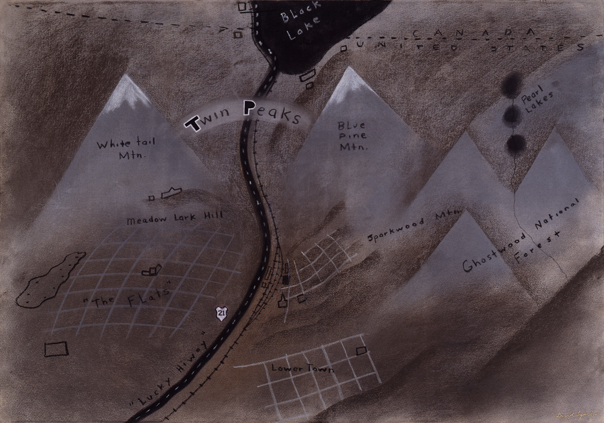
Another Lynch map of Twin Peaks
from welcometotwinpeaks.com
More on the 1991 Access Guide to Twin Peaks at the website Twin Peaks Pop Apostle.
LAURA IS SNATCHED FROM THE RED ROOM
VENUS, SATURN, JUPITER AND THE RED ROOM / THE TWO VENUSES OF THE RED ROOM / REPETITION OF THE "SOMETIMES MY ARMS BEND BACK" SCENE / THE REPEATING ELEMENT OF "IS IT FUTURE OR IS IT PAST?" / COMPARING THE-TREE-AS-THE-ARM WITH SIMILAR TREES AND THE MONSTER-CHILD IN ERASERHEAD / THE SHIFT OF THE FLOOR IN THE RED ROOM FROM THE ORIGINAL SERIES / THE FBI PIN
(1) 15:08. The strum of a
guitar. The Red Room drapes. (2) Venus. (3) The Red Room.
In the intro for part one we were not shown the whole Red Room in the
revisiting of Cooper and Laura and her prophecy that they would meet
again twenty-five years in the future, this repeating what had occurred
in the final episode of the original series.
Now is the first
time in The Return we see the whole room--the Venus behind the
sitting area of two chairs on the right and one on the left, the fluted
floor-lamps, the rings of Saturn lamp on a side table. As I mentioned a
couple of paragraphs above, the entrance to the Black Lodge supposedly
opens at Glastonbury Grove when Saturn and Jupiter are aligned, but this
must be a symbolic rather than literal event. As we can see, in the Red
Room we have a Saturn lamp and a statue of Venus, however Venus doesn't
appear to be symbolically represented on the petroglyph that shows
Glastonbury Grove. On the petroglyph, the sign for Saturn is next to the grove.
The sign for Jupiter is located next to a fire in which appears the symbol
found on a green ring which I will give a little of the history on in
part three.
The Venus observed is the capitoline type in which Venus covers her
breasts and groin with her hands, which is the Venus Pudica or
modest venus, deriving from the Aphrodite of Cnidus by Praxitales. It
may be significant that the modest Venus, the one who discreetly hides
parts of herself, is the Venus of the Red Room. The hiding is less
concerned with modesty as typically understood than with the unknowable
divine. Often, in myth, when the naked goddess is observed, the observer
is blinded. Though the blinding is a penalty, and may be only a punishment, at other times it is associated with the reception of mystical perception.
Though Venus, born out of the ocean on a shell, is
associated with love and beauty, she was also a goddess of contention in
her representation of desire. Which may lead us to reflect on how
Mr. C is so fixed on making it known that he "needs" nothing, that he
instead wants.
Venus, goddess of love and beauty, is not known
for her fidelity.
(4) Now Agent Cooper, as he is
in the present, sits in the chair beside the Saturn lamp. (5) He looks to his left and sees the One Armed Man
(aka Phillip Gerard, Mike) seated in the chair in which the Man From
Another Place was always seated in the original episodes. Phillip
Gerard is frozen in time, unmoving. Then he becomes unstuck and speaks. He is like the coffee that The Waiter served Cooper in the Red Room, congealed and then flowing.
GERARD: Is it future or is it past?
(6) Cooper considers what has has been said.
(7) GERARD:
Someone is here.
Gerard disappears. (8) Cooper observes the empty chair. (9) The empty chair. (10)
Cooper. He hears something and looks up, away from the chair. (11) Laura Palmer enters. As she walks her shoes
making a sound that is similar to a skipping record at the end of a
disc. She sits in the chair in which she was seated twenty-five years
beforehand. (12) Cooper looks on, mesmerized.
(13) Laura. (14)
Cooper watching her with anticipation.
Laura and other
denizens of the Red Room use backwards Lynchian speech, the actors
having spoken their lines phoneticially backwards, then when the
footage is reversed we have an odd-sounding speech approximating what
it would be normally. Cooper is recorded normally.
This scene is a partial recreation of one in the original series. In the
original series, Cooper had been artificially aged twenty-five years so
that he had dry, wrinkled skin but his features otherwise unaltered.
Laura was a young woman. The Laura here, despite having been murdered,
has also aged.
(15) LAURA: Hello, Agent
Cooper. (16) Cooper. (17) LAURA: You can go out now.
(18) Cooper. (19) LAURA: Do you recognize
me?
(20) Cooper. (21) Laura. (22) COOPER: Are you Laura Palmer?
(23) LAURA: I feel like I know
her, but sometimes my arms bend back.
(24) COOPER: Who are
you?
(25)
LAURA: I am Laura Palmer.
(26)
COOPER: But Laura Palmer is dead.
(27) LAURA: I am dead, yet I
live.
(28) Cooper regards her. (29) She reaches up and begins to pull back the mask
of her face. (30) Cooper watches. (31) She pulls back the mask of her face to show a
bright white light behind it, then fits the mask of her face back on.
(32) Cooper stares in amazement. (33) Laura smiles. (34)
Cooper continues watching her. (35) Laura.
(36) Cooper asks Laura, "When can I go?" (37) Laura. (38) She rises, goes to him, leans down and kisses him. She whispers something in his ear (39) to which he responds with shock, even groaning, an unsettling expression as Cooper is not one to show agony. (40) Then something happens, attracting her attention upward (41) and his as well. (42) There is a whooshing sound as the curtains shake violently. (43) Laura raises her hands, frantic. (44) She is violently drawn up into the sky (45) as the curtains wave, (46) we've a close-up of her face as she fades (47) against the zigzags of the floor (48) and is sucked up out of the room, screaming. (49) Bewildered, horrified, Cooper stares up. He then drops his head and looks at the curtain beyond.
Laura's revelation that sometimes her "arms bend back" is one of the more famous lines in the original series. This occurred in a Red Room dream of Cooper's in the "Zen or to Catch a Killer Episode" in which, as I've previously related, Cooper was made up to ostensibly appear to be much older. It was also in that episode that Laura had kissed him and whispered in his ear. Cooper woke and said he knew who Laura's killer was, but then he went back to sleep and forgot what he knew by morning. In a later episode, with the waiter remarking to Leland that the gum he liked was coming back in style, Cooper flashed back to the dream and remembered Laura saying that her father had killed her. But one has the feeling he hears something different in this second iteration for the fact that Leland killed Laura would no longer be a shocking revelation to him. Cooper is already aware that her father killed her.
The top video is the original dream Cooper has of the Red Room and meeting Laura, while the 2nd video is from the 2nd season's end, showing select scenes. The dialogue in in The Return is not quite the
same as in the original episode. Laura pulling back the mask of her face
is a fresh element, as is the terrible event of her being then ripped screaming from the
room, though there may be a parallel had with Laura's doppel screaming. As if it isn't bad enough having been murdered and now somehow stranded in The Red Room, even though, at the end of Fire Walk With Me, in The Red Room the spirit of the murdered Laura looks to be at peace when she sees an angel.
The below Youtube video does a lovely job of editing together past and Return scenes from The Red Room.
(50) A great wind comes through which blows the curtains (51) as Cooper watches. (52) The curtains blown completely away a white horse is seen in the black distance. (53) Cooper. (54) The camera zooms into the black beyond the horse.

Horse
(55) We are shown the zigzag floor shaking violently. (56) Then suddenly we return to Gerard seated on Cooper's left as he was earlier, frozen, stuck in time. (57) Gerard regards him. (58) Then Gerard moves and asks again, "Is it future or is it past?"
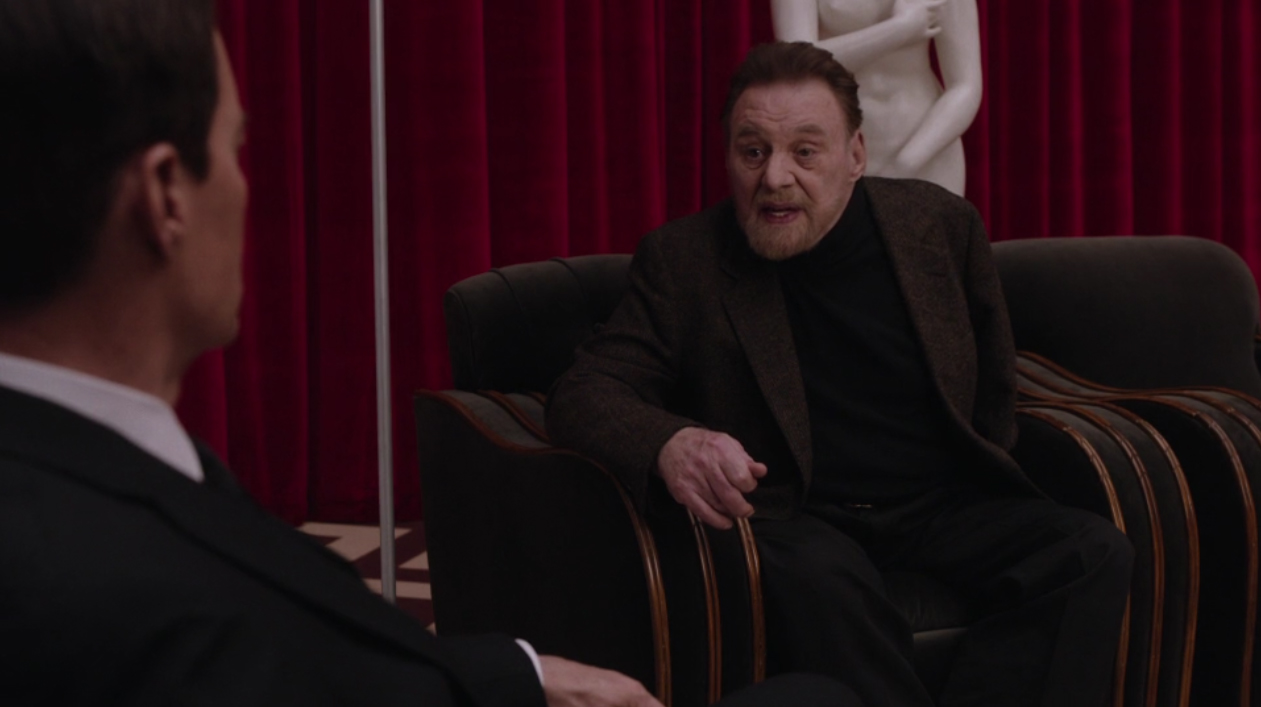
One Armed Man
Gerard inquires again, "Is it future or is it past?" Is this a repetition of the question during the same meeting? Or is this another meeting that begins as a repeat of an earlier one? In the first meeting, Laura had then appeared. Now there is no Laura and instead Cooper is taken to meet the evolution of The Arm. It may be that Laura is not met again as she has disappeared and her disappearance may play a part in the evolution of The Arm.
(59) Cooper looks from him
across the room (60) and sees Gerard
standing in a distant corner before the drapes. Gerard gestures for him
to come to him. (61) Cooper rises. (62) Gerard passes through the drapes. Cooper
crosses the room and follows him through the drapes.
(63) They are then both in the Red Room corridor. As
they come toward the viewer, Gerard draws back the curtains on screen
left and Cooper passes through them.
(64) They enter a room in which is a barren tree,
crackling with electricity, (65) a blob of
flesh-like matter perched on the top of the tree.
(66) GERARD: The
evolution of the arm.
(67) THE TREE AS THE ARM: I am the arm and I sound like
this. (We hear a peculiar whooshing amidst the crackling.)
(68) Cooper watches.
(69) THE TREE AS THE ARM: Do you
remember your doppelganger?
(70) Zoom in on Cooper. A wobbling whoosh sound and then we see, from the final episode of the original seasons, (71) the doppelganger laughing with Bob in the finale. (72) We see Cooper as he is now. (73) And then return again to the doppelganger, laughing, running through the Red Room. (74) We see Cooper run down the corridor, followed by the doppelganger, (75) the scene in which the doppelganger catches up with Cooper, as he attempts to leave the Red Room. (76) We see Cooper as he is now.
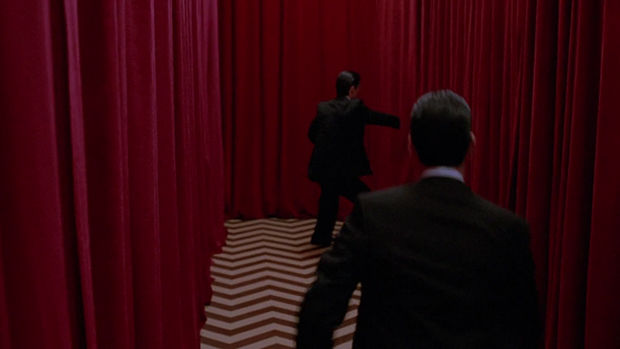
Cooper chased by the doppelganger
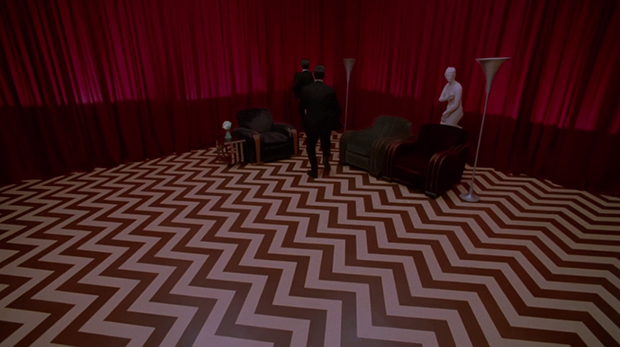
Cooper caught by the doppelganger
(77) THE
TREE AS THE ARM: He must come back in before you can go
out.
(78) Cooper. (79) The tree. (80) Cooper
and Gerard. (81) Cooper.
If we are on the same timeline, in the Red Room, as Hawk who shined a light onto Glastonbury Grove,
he had the knowledge something was to happen that night, as did Margaret's log. Margaret said they were on the same page. . We
are not shown what happens from Hawk's POV, instead we go to the Red Room where Cooper
is being prepared for leaving it, and we assume that Cooper will likely
leave the Red Room through Glastonbury Grove. We see a meeting with
Laura Palmer, she shows the light within, and after kissing Cooper she is swept away, whereas in the original dream sequence Cooper woke up. Maybe her screaming and disappearing has to do with his originally waking up, that is something to consider.
There are different ways to take Laura's pulling back
her face to reveal light. One might be the revelation of the individual
spirit within a universal spirit. But one could also argue that she has
become a sort of Schrodinger's cat that is dead and yet lives.
When a white horse appeared in the original series it was
in connection with death, specifically occurring before Laura's death,
seen by Sarah Palmer, Laura's mother, and again seen by Sarah
before the murder of Laura's identical cousin, Maddy. Is it a foreboding
of death in this instance, or does it refer back to these other
deaths?
We then seem to begin again and instead of seeing Laura there
is a meeting with The Tree as The Arm encouraging Cooper to remember
his doppelganger. We learn that Cooper's doppelganger must return to the
Red Room before he is able to leave.
We no longer have The Man From
Another Place, who was in the original series and with whom Cooper had typically dialogued in the Red Room,
The Man from Another Place acting as a kind of host. Instead there is now Phillip Gerard. He had once been an ally of BOB through being a host of
Mike, much as how Leland was a host of BOB, but then Mike had seen the "face of god", had changed, and made it his mission to pursue
and stop BOB. After Laura's unsettling disappearance from the Red Room,
and the beginning again, Gerard takes Cooper to show him the current incarnation of The Arm, which
had formerly been represented by The Man from Another Place, yet he was
also the arm that Phillip/Mike had cut off, that had the tattoo that was
both MOM and Fire Walk With Me. The Arm is now a tree that resembles the
bare sycamores surrounding the black pool of oil in Glastonbury Grove. As
I've pointed out, there are only eleven trees shown in the map, when
there are supposed to be twelve, so perhaps it is the twelfth
tree.
Though it
may seem absurd, I keep thinking of Hawk being the one to guide us,
tonight, to Glastonbury Grove, knowledgable that something was to
happen, and Lynch/Frost having his flashlight shine in our eyes,
blinding us with white light, Hawk's eyes looking directly at us. Then when we have
Laura peeling back her face to show the bright white light as proof that though she is dead she also lives, she occupying two states of being, these
things feel at least poetically, artistically related. But it also makes
me wonder if Hawk's presence was also essential at the Grove for this
interchange. We are not shown what he sees, after all. We don't know why
he is there. But it seems he must be there for a reason.
The
fleshy blob on The Tree as the Arm reminds of the face of the entity
that appeared in the New York glass box and attacked Sam and
Tracey.
This barren tree has been hanging out with Lynch as a
symbol for a good while. It appears also in Eraserhead. We
see the tree in Henry's room, perched atop a mound of earth beside
his bed. Above the tree looms an atomic bomb's dust and fire mushroom cloud.
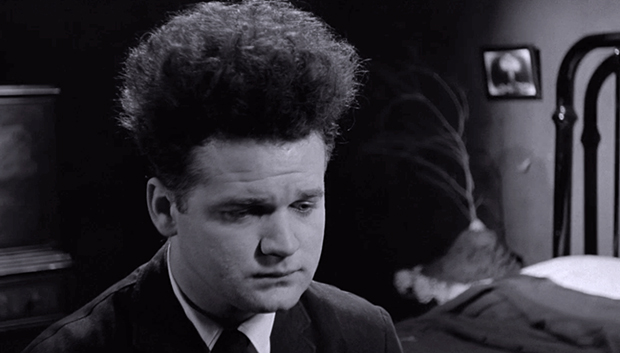
The barren tree in Eraserhead.
The tree also appears in a seeming dream of Henry's, only it has enlarged and from its roots flows a pool of black liquid, presumably blood. Henry has been standing in a kind of cross-examination box. His head pops off and lands in the pool of black/blood. When his head pops off it's revealed that beneath it he has the same head as the grotesque creature he is given as having fathered.
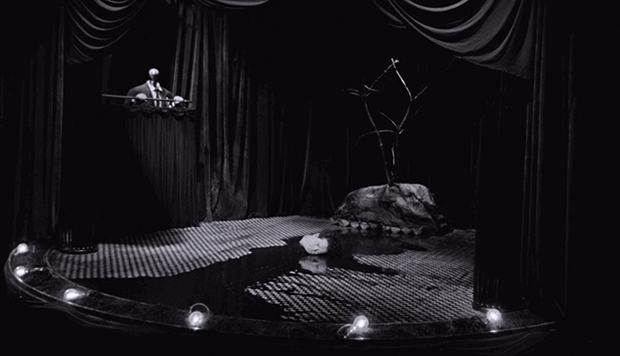
The large version of the barren tree on
stage.
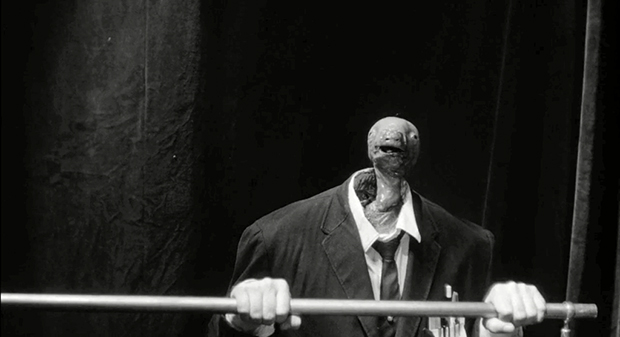
The head of the child-creature revealed as Henry's
head.
The head of the child-creature, which becomes Henry's
head, bears a distinct resemblance to the head on The Tree as The Arm,
and even the head of the Experiment. A difference is that the
child-creature has eyes and ears. The Experiment has only its mouth, as
does the head on the tree, and the Experiment uses that mouth to shred
and devour.
Before continuing, note that by now Lynch has given us ample
opportunity, by means of this flashbacks, to see that the floor of the
Red Room and its corridor has shifted 90 degrees from the original
series.

Cooper chased by the doppelganger
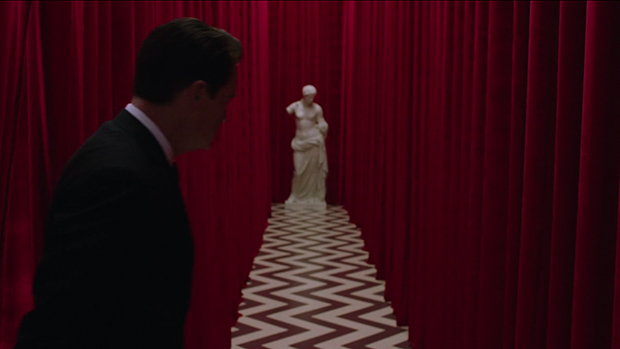
Venus in the hall
Cooper chased by the doppelganger in the old series has the hall turned 90 degrees from Cooper twenty-five years later.

Cooper caught by the doppelganger
Cooper chased by the doppelganger in the Red Room shows
the floor turned 90 degrees from its reintroduction twenty-five years
later.
I don't expect everything to be the same twenty-five years later, I expect there to be some differences in design. We've observed that
Ben's office at the Great Northern is so close to the aesthetic of the old hotel
that we don't greatly notice the differences. Besides which, our focus
is generally on the large indigenous painting backing his desk. And the
same for the sheriff's department, there is so much the same aesthetic
that we aren't bothered by design alterations to Lucy's reception area, the
conference room etc. I'm not inclined to pay heed to those changes. (Or should we?) But
it's a little different with the Red Room. The zigzag floor is so iconic that the
90 degree turn seems significant, marking the old series from the Return.
Kubrick used 90 degree shifts in The Shining, the most well-known of which is the 90 degree shift of the entrance to the maze. The Red Room, as we have seen, also functions as a maze.
A last consideration--when we saw Cooper with ??????? he was not wearing his FBI pin. He was wearing the FBI pin in this scene.
THE MERCEDES HIDDEN
THE HUMILIATING MASSAGE OF JACK'S FACE / RECALIBRATING AUDIENCE RESPONSE TO AGGRESSION
(1) 25:17. Abruptly, we are back in Buckhorn. Jack is hiding Mr. C's Mercedes in a blue garage, closing the door. Mr. C gestures for Jack to give him the keys to the door then also the keys to his new car and Jack does so.
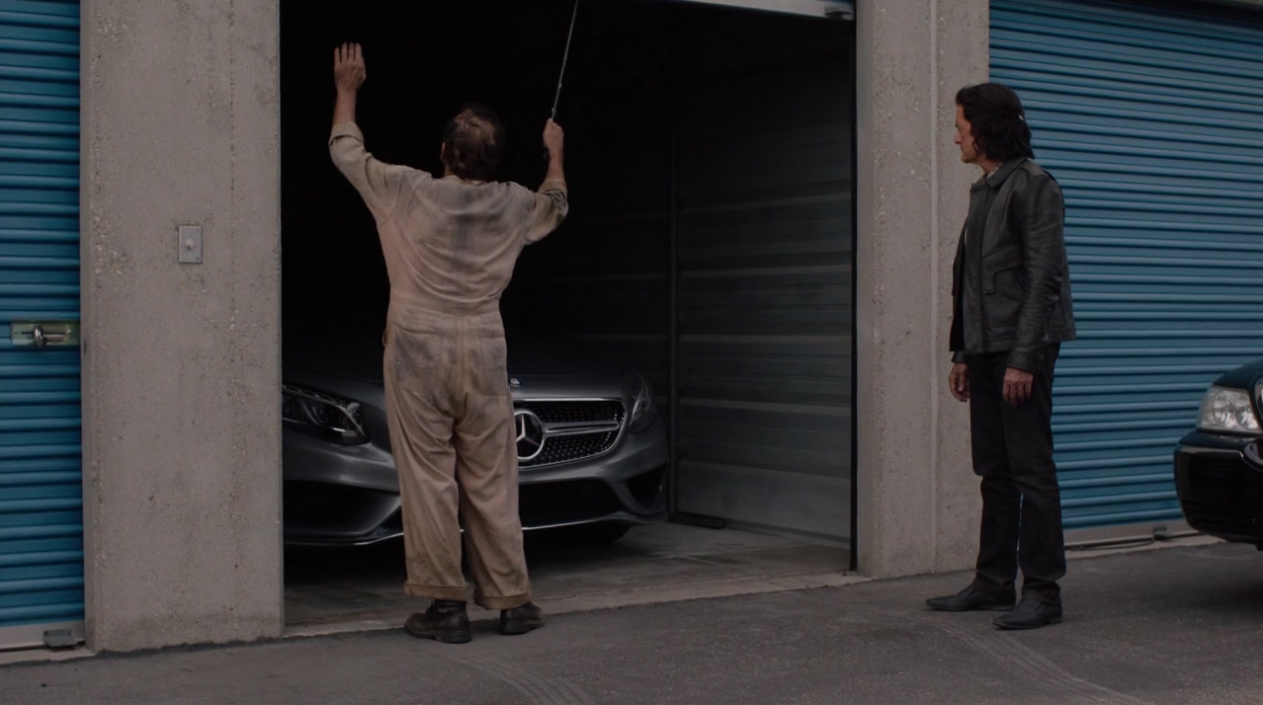
Hiding the car
(2) Mr. C goes to his new car. He has changed out a 2015 Mercedes-Benz S-Klasse Coupe (C217) for a 2003 Lincoln Town Car. (3) He opens the door. Then Mr. C, having opened the door of the car, says, "Jack, come here." (4) Jack obeys. (5) Mr. C takes hold of Jack's jaw (6) and begins peculiarly massaging it. Jack does not object. He even behaves as though hypnotized, but it is difficult to tell with Jack, who has been silent, who has said nothing in the two scenes with him. (7) C continues massaging Jack's jaw, watching him intently. (8) We view Jack's absolutely disquieting acquiescence. (9) C again. (10) Jack. (11) C. (12) Jack. And Mr. C's hand now stops massaging Jack's jaw. Jack doesn't move. It is as though he is paralyzed. It may even cross our minds that by this action, somehow, C has killed Jack.
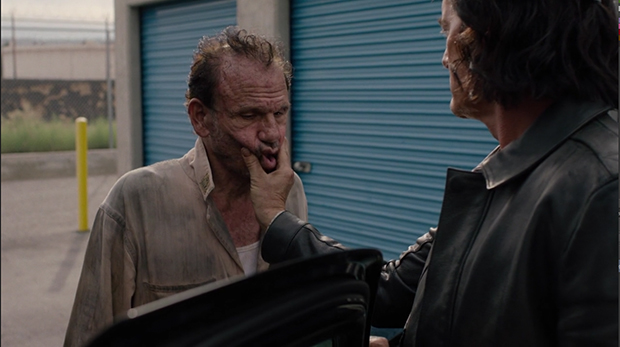
Mechanic
The scene seems to exist less to inform us of the
hiding of the Mercedes, than to let us see Mr. C manipulate Jack's face
as he does, with the focus on the mouth reminding of the face of the
entity that attacked Sam and Tracey, and the fleshy blob surmounting The
Tree as the Arm. This man, never speaking, a blank, behaves almost as
one dead, a zombie that does as it's told and eats. Mr. C's manipulating
Jack's mouth as he does suggests a kind of fascinated repulsion. It is a
display of power, but one wonders at the rationale behind the
humiliation.
We have had the horrifying murders of Sam and Tracey, Ruth, and Phyllis.
Mr. C simply molds Jack's face with his hand, and following after
those murders the viewer may have a heightened sense of just how
aggressive, how terrifying, even an action such as this
is. Murderous in its manipulation.
On another level, I wonder what it is that Jack represents, considering the emphasis on the three dinners he'd devoured at the restaurant, and how those dinners played into the idea of repetitions, of cycles. I have wondered if, for Mr. C, Jack might not represent to him these repetitions.
THE MURDER OF DARYA
WHAT MR. C WANTS / REPETITION WITH SLIGHT DIFFERENCES / THE PECULIAR CIRCUMSTANCES OF RAY LANDING IN PRISON / BUCKHORN'S LOCATION / LET'S TALK ABOUT PHILLIP JEFFRIES / AND JUDY / AND WHO WAS ACTUALLY SPEAKING WITH MR. C / JEFFRIES' REAPPEARANCE IN 1989 COINCIDENT WITH A SPLITTING OR DOUBLING OF COOPER'S REALITY / CONSIDERING THE MEANING OF THE USE OF THE BLACK HILLS / DOES BUCKHORN HAVE ANY ASSOCIATIVE RELATIONSHIP WITH THE HORNE'S AND THE HORNE LODGE
(1) A distant view of forest on the mountains. Thunder and lightning at sunset. (2) The storm continues. As Mr. C pulls up to room 6 at the motel, we hear thunder. As he gets out of the car, he is looking at his phone, then puts it up as he approaches the red door.

The motel
(3) Inside the room is Darya,
in her underwear, speaking on a turquoise color, push-button phone.
"Shit," she says, hearing C. "He's coming. I have to get off the phone."
(4) She puts down the phone as Mr. C opens the
door and enters. (5) She lies back on the bed,
seductively positioning herself, and addresses him, "Hi, baby."
(6) MR. C: Who are you talking to?
(7) DARYA: Uhm,
Jack. (8) C at the door. (9) C crosses to the bed. DARYA:
Just making sure I get the job done on the secretary's car.
(10) MR. C: What
did Jack say?
(11) DARYA: He said it's all good to go. (12) C crosses to the other side of the room. (13) DARYA: I'm happy to see you.
(14) C looks out the window. (15) DARYA: I thought maybe you'd
gone off on your own for a little while, like you were saying.
(16) MR. C:
You're happy to see me, Darya?
(17)
DARYA: Yeah, baby.
(18) MR. C: That's nice, Darya.
(19) Darya.
(20) Return to Doppelcoop. MR. C: Ray was
supposed to meet me this afternoon. He never showed.
(21) DARYA: Oh,
yeah?
(22) MR. C:
Yeah. Where's that .45 of yours, Darya?
(23) DARYA: I've got it here by
the bed. What's up?
MR. C: Might want to borrow it for a
job.
(24) Mr. C had crossed the room
to check a rear window behind a curtain. Return to Darya as he crosses to
the bedside table and takes her gun. DARYA: What's
mine is yours.
(25) Mr. C. (26) Mr. C climbs over Darya and settles on the bed
beside her. She nestles under his arm. (27) CU
of Darya under C's arm. (28) Medium shot to
zoom in on Mr. C and Darya. MR. C: Darya, Jack is
dead. (29) CU of Darya and Jack.
MR. C: I killed Jack two hours ago after he wired the
car. (30) Long shot. Terrified because she is aware C knows she was lying about talking to Jack, and because Jack has been killed, Darya attempts to
pull away and C holds her. (31) Close-up side
view of the pair. (32) Front view C and Darya.
Mr. C: Don't move one muscle. I'm going to play
something for you, Darya. (33) C pulls
out a recorder.
(34) Front
medium-shot of Darya and C. MR. C: I think we'll both
find this interesting.
DARYA ON RECORDER: Ray, where the hell are
you?
RAY ON RECORDER: Federal prison, South Dakota.
DARYA ON
RECORDER: What the fuck? What did you do, Ray?
RAY ON RECORDER:
Carried weapons over the state line. I fucked up. The worst possible
moment.
DARYA ON RECORDER: How are you calling me?
RAY ON
RECORDER: This is a burner. Don't worry about it. Nobody's
listening.
DARYA ON RECORDER: So what do we do about Cooper?
RAY
ON RECORDER: I got another call from Jeffries. You have to hit Cooper if
he's still around tomorrow night. That means you now, Darya. You have to
do this.
DARYA ON RECORDER: Fuck! Fuck! I think his car pulled up.
Fuck! Let's see what happens tomorrow. If I have to, I'll take him out.
Shit, he's coming. I got to get off the phone.
A reason we may find it interesting is that earlier Darya had said, "He's coming. I have to get off the phone." In the recording she instead says, "He's coming. I gotta get off the phone." I have been talking about repetitions, cyclings, and here is a repetition that is slightly different.
(35) Mr. C turns off the
recorder. (36) Darya again attempts to get
away. (37) Long shot of Darya and Mr. C
struggling. (38 ) He slams her back. (39) He slams her back again.
(40) Again. (41) He holds her tight as
she ceases to struggle. (42) He smoothes her
hair back. (43) Return to front medium-shot.
(44) The side. (45)
From the front again.
DARYA: Are you going to kill me?
MR.
C: Yes, Darya.
(46) After a long pause, yelling, "Shit!", she tries to get away. (47) He slams her back (48) and he punches her in the face. (49) He pulls her back up to a seated position and we see he's drawn blood. (50) Again, he smoothes her hair back.
We have learned, from this conversation, that Bill Hastings' secretary's car has been wired, which means she is to be killed. We learn that a man named Jeffries has hired Darya and Ray to kill Cooper (more on this Jeffries in a second). We learn that Jack has been killed by Mr. C but the "why" of the murder is unknown to the viewer. Did Mr. C feel Jack knew too much? Did he simply kill him because he wanted to kill him? Is it likely that even if Darya hadn't betrayed him, Mr. C would have killed her as well? Had he hired Jack, Darya and Ray for this work in Buckhorn, thinking of them as only expendable, and planned from the beginning to kill all three?
(51) MR.
C: Darya, who hired you and Ray to kill me?
(52) DARYA: I don't know.
(53) Change perspective to front medium-shot.
DARYA: I swear, I don't. Ray knows. (54) From the side. DARYA: I
don't know. He never told me.
Okay, well, that's confusing. First, on the recording, it sounds like Jeffries hired Ray and Darya to kill C, but now Cooper's asking who hired them even though Ray said he had talked to Jeffries? Does this confusion have anything to do with the other confusion of how Darya said one thing before C entered the room and in the recording she said something slightly different? Or is this a bit of unclear writing and we are supposed to understand that Jeffries relaying information to Darya and Ray on killing C is not the same as hiring them to do so? Or does Darya simply mean that she has never met Jeffries and so she doesn't know who he is? Perhaps this latter. I don't know. There is much that is perplexing about the conversation, which we tend to pass over because dude has a strangle-hold on a woman, is throwing her around, and is about to kill her. Our concentration isn't going to go to the little details that make our brains pucker and ask, "What's up with that?" Our focus is on poor Darya, who you know C is not going to have any second thoughts about wasting. We might also think, well, poor Darya (and Ray) ought to have known better than to mess with C. They're not smart enough. They don't have his resources. As soon as he set eyes on them, they should have run in the opposite direction.
(55)
MR. C: Do you really expect me to believe that Ray's in prison for
carrying guns over a state line? Darya, look at me. (56) He prods her to look at him. Mr. C: This is quite an interesting thing to think about.
The game begins. (57 ) Perspective
change. MR. C: Did he say why they want me dead?
DARYA: No, I don't know. Why?
MR. C: How much do they want me dead?
What are they paying you?
(58) DARYA: We'd split a half a million.
(59) Perspective change.
(60) Front close-up. DARYA: I wouldn't have
done it. (61) Side view. DARYA: I just said that to Ray.
MR. C: Shut up,
Darya.
(62) Front view. DARYA: But
you said you were going away somewhere tomorrow.
MR. C: Tomorrow I'm
supposed to get pulled back into what they call the Black Lodge.
(63) MR. C: But I'm not
going back there. I've got a plan for that one. (64) MR. C: But this prison thing
with that fucker, Ray. (65) MR. C: Darya, did Ray get that information from Hastings'
secretary? (66) He jostles her, she
crying. MR. C: Did he ever mention coordinates to
you?
DARYA: I don't know what that is.
MR. C: Geographical
coordinates... (67) Mr. C: ...numbers, letters.
(68) Coaxing her. MR. C: They could save your
life.
DARYA: He said she told him something but I don't know
what.
(69) He moves to (70) pull out a playing card from his inner jacket
pocket. MR. C (showing Darya the card): Anybody ever
show this to you before? (71) The
back of the card as it is shown to Darya.
(72) The card's face. MR. C: Do you know what
this is? (73) Darya looking at the
card. (74) Close-up of Mr. C. MR. C: Did you ever see anything like this? (75) Darya looking at the card. MR. C: This is what I want.
(76) He smiles. (77) He puts the card
away.
(78) DARYA: Are
you going to kill me now?
MR. C: Yes, Darya.
The style of Darya's underwear may bring to mind
Victoria's Secret, but also may remind of the women at the One Eyed
Jack's casino and brothel in the original series. That Mr. C shows Darya
a playing card may serve to highlight this. Cooper had rescued Audrey from One Eyed Jacks, and she had been doped up on an heroin. Though he had only seen her in street clothes, one might wonder if Mr. C has had Darya attired this way to remind of Audrey and One Eyed Jacks.
The Ace of Spades is
sometimes referred to as the death card. The rips and scratches on it may recall the violence with which the Experiment had attacked Sam and Tracey. However, the Ace of Spades traditionally shows the maker of the deck, such as above and below the symbol, so the scratches and tears may also represent this.
The symbol on the card reminds of a symbol we have seen on a mysterious green ring that appeared several times in the original series and is associated with the Red Room. This is different, however, from the other. It's not an exact duplicate.
Design wise, the lacy blue and white pattern of the back of the card, against the white lace over the red cups of Darya's bra, emphasizes how she is dressed may be intended to remind of the One Eyed Jack's casino, and perhaps, in Darya's case, she is intended to evoke something like the Queen of Hearts.
The owl ring. Should I now go into the owl ring, the symbol on it that this card may vaguely resemble? I'll wait until Part 3 because we're about to take up some room concerning Jeffries.
A spade is a shovel. Jacoby has shovels. Lots of shovels. Those shovels were important enough that they were introduced immediately in The Return.
(79) They fight. She screams.
(80) He presses her down on the bed as she
screams. (81) He knocks her out, puts a
pillow over her face (82) takes the gun
(83) and shoots her.
(84) He straightens. (85) Removes the
pillow so we see she is dead, both eyes open and staring up. (86) He throws down the pillow
(87) on her face (88) then goes to the
bathroom to wash up. (89) A view of Darya on
the bed.
This is a hard scene. Harder than the murders of Sam and Tracey because those deaths were supernatural and what happend was mostly hidden. It's harder than what we saw at Ruth Davenport's because Ruth was already dead. It's harder than the murder of Phyllis, which was bang and over with. Here, we have the desperate struggle of Darya and C, he socking her hard in the face multiple times, then shooting her. This is an emotionally taxing, difficult scene.
(90) He brings out of the bathroom a
briefcase and sets it up on the table. Runs a line and makes a call.
MR. C: Phillip?
MAN: You're
late.
MR. C: Couldn't be helped.
(91) Another view of Darya, as in 89. MAN: I
missed you in New York but I see you're still in Buckhorn.
(92) Return to Mr. C at the table. MR. C: And you're still nowhere. Is that correct?
MAN:
You met with Major Garland Briggs.
MR. C: How did you know that?
Phillip?
MAN: Actually, I just called to say goodbye.
MR. C:
This is Phillip Jeffries, right?
MAN: You're going back in tomorrow
and I will be with BOB again.
MR. C: Who is this?
Mr. C had just played a recording in which it was
revealed that Jeffries is giving orders to Ray and Darya on the killing of C. Now, Mr. C
calls who he believes to be the same Phillip, their conversation showing
they have some sort of relationship. But is it Phillip Jeffries after
all? We have heard the voice of Phillip Jeffries in Fire Walk With Me
and he had a deep southern American drawl. This individual does not.
If we had wondered if Mr. C was likely responsible for the deaths of Ruth and Garland, now we have it confirmed, by this man who may or may not be Jeffries, that he is aware C met with Garland Briggs.
If we had wondered if Mr. C had anything to do with the glass box in New York, we now have reason to believe that he likely does have, though we don't know exactly what it means when the individual says he missed C in New York.
Is this Jeffries? It doesn't sound like Jeffries. Would Jeffries talk about his anticipation of being with BOB "again"? Would FBI agent, Jeffries, have switched allegiances so that he is a part of the Black Lodge? Did Jeffries hire Ray to kill Mr. C? Obviously, C believes he has Jeffries' number and has called it, so how is this other individual answering?
The other individual hangs up. (93) C
brings up the FBI site on the computer. He begins to enter password
info. (94) Cut to Mr. C.
(95) We are shown a map placing Buckhorn between the Bear Lodge
Mountains of Wyoming and Rapid City, in the Black Hills. The red dot is
in the vicinity of a real town called Whitewood, which is on I-90.
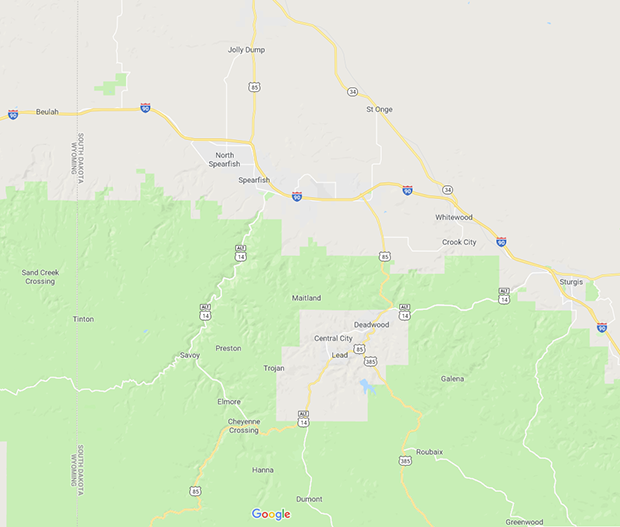
Buckhorn located approximately where Whitewood is
Zooming out we see a pointer above the Yankton Federal Prison. (96) Medium shot of C.
(97) C enters a search for: sdl04pcsecprot. It yields,
Yankton Federal Prison, South Dakota - Level 4 Security System. (98) View of C. (99) He
enters the pass information, Organization - mkeuouc-q, Name - eeuoubp3x,
ID number - 3987150515787412. Logs in. (100)
Medium-long shot of C. (101) He downloads
data including blueprints. (102) He watches
the download. (103) Download. (104) He watches the download.
(105) Download completes. (106)
Close-up of him. (107) He leaves the room.
(108) Stepping outside, we
hear the rain as he goes over to the neighboring room, #7, and knocks on
the door. A woman, Chantal Hutchens (Jennifer Jason Leigh), calls out,
yeah, and he replies, "It's me." She opens the
door (109) and lets him into a room strewn
with chip bags.
MR. C: I need you to clean up in room six.
Everything.
CHANTAL: Darya? That's good news. I was getting so
jealous of that bitch.
MR. C: Then go get your husband. I need you
and Hutch in a certain area in a few days. I'll get word to you.
CHANTAL: Okay, boss.
MR. C: Chantal, come here. (She stands before
him with arms raised and he feels her up.) Oh, you're nice and
wet.

Chantal at the Motel Room Door

Chantal
Chantal's
pose is as was Detective Dave's when he entered Ruth's bedroom and
Constance checked him for his gloves. I had noted in the first part how
Dave's interaction with Constance carried on the "bad girl" theme
begun with Tracey. Dave was said to be behaving himself by wearing his gloves.
Perhaps one of the more curious elements of
the scene with Darya (other than the recorder showing a change in dialogue) is that we hear Ray, on the recorder, telling Darya
that he's in prison for having carried weapons over the state line, yet
Mr. C says, "Do you really expect me to believe that Ray's in prison for
carrying guns over the state line...this is quite an interesting thing
to think about. The game begins..." Darya seems to have believed her
conversation with Ray wasn't tapped, and Ray gave out information it
would seem he wouldn't have wanted Mr. C to know. If neither Ray nor Darya knew
the phone was tapped, there would be no reason for either to give
misleading information. Because of this, one wonders why Mr. C would
question that Ray is actually in prison for carrying guns over the state
line. A rationalization might be that Mr. C knows something Darya
and Ray don't know and that he believes that Ray is in prison for
perhaps another reason. For all we know, Mr. C could be referring to
"the game", as in the grand plan, an outside entity or force intruding
upon the situation and which has caused Ray to be arrested. If this
isn't the case then the writing is itself inordinately vague. We know it is purposefully vague, and must take for granted this is for a reason. We are intended to be kept guessing about all these particulars.
Ray was to get the co-ordinates trom Hastings' secretary and Darya was
dealing with Jack having the secretary's car wired, presumably to kill her.
But we find they have been hired by Jeffries to kill Mr. C, and for a
fair amount of money. They would appear to have no knowledge of the
Black Lodge, or at least Darya betrays no knowledge of it. We learn from
the call Mr. C makes afterward that he believes he is calling Phillip
Jeffries, who is an FBI agent who disappeared many years ago.
So, let's talk about Phillip Jeffries. Fire Walk With Me has in
it a scene in which Cooper keeps entering a hall because of a dream that
he's had that concerns 10:10 AM on February 16th. It is Feb 16th 10:10 a.m. and so he acts as he had in a dream that he seems to believe was prophetic.
Cooper enters the hall and runs back to look at a
monitor of his presence in the hall. (We must assume that he had done this in the dream or that he was seeing footage of himself on the monitor in the dream.) He does this several times, then
finally he splits and becomes two presences, for he remains on the monitor, observed as being in the hall, even though he
has run back in to look at the monitor. Is this the creation of Cooper's
doppelganger? Is it the glimpse of another timeline? He is in two places at once. At this point, Phillip Jeffries, who had disappeared in
1987, comes down the hall after exiting an elevator and passes by the frozen form of Cooper who gives no recognition of Jeffries having passed him.
The Cooper who was watching the monitor rushes to Gordon Cole's office
and finds Jeffries already in it. Cooper and Jeffries had never met
before. Jeffries begins by saying that they're not going to talk about
Judy, then he asks, of Cooper, pointing to him, "Who do you think this
is there?" We begin to see a superimposition of a scene of some of the
otherworldly entities in a meeting above a convenience store. Jeffries
insists we live inside a dream, he speaks of the meeting, he was at one of their meetings, he exclaims
that he found something and then "there they were". He disappears. When Albert calls the
front desk they say that he was never there, and have news that Chet Desmond has disappeared from Deer Meadow, which means this would be February 16th 1988 as Teresa Banks, the death Chet was investigating, was killed Feb 9, 1988.
The Missing Pieces provides a little more
dialogue for Jeffries. Jeffries leads by saying that "Judy is positive about this". Whatever it was that he found, it was in Seattle, at Judy's, and then "there they were". In the screenplay, after a woodman says, "Thus time moves on", Jeffries says, "I followed...the ring...the ring." Some suggest that what Jeffries had found in Seattle was the ring that had transported him to the room above the convenience store.
Other materials add the information that Jeffries, before his disappearance in 1987 was at the Palm Deluxe hotel in Buenos Aires, where upon his arrival he had asked the desk clerk about "Miss Judy" and was given a letter that the "senorita, a young lady" had left him.
In The Missing Pieces Jeffries is shown at Cole's desk, realizing with great shock it is February 1989, not 1988. Two years have elapsed. The lights and mechanical devices have begun flipping out. Cole, on the phone, yells, "May day", then referring to the absence of assistance asks if he is alone in there, at which point Jeffries disappears. We then see Jeffries reappearing in the hotel in Buenas Aires, a flash burn on the wall beside him, and a bellhop and maid in a panic, the bellhop asking him where he had gone.
So it seems that Jeffries disappeared at the hotel, in
front of others, in 1987, was gone for one or two years, made an
appearance at the FBI office in 1988 or 1989, then suddenly was back and
screaming at the hotel from where he had only been gone a matter of
seconds in 1987. After this he again disappeared.
Jeffries' behavior, arriving off the elevator, is as one who has a solid history without gaps, as if he knows where he is coming from, that he hasn't just stepped in from out of the blue. But he is also clearly traumatized, physically unstable, and the way he relates this story he is there to tell is spotty and largely incoherent. One wonders what has happened and why he appears at the FBI office exactly then.
Who is "Judy" is a
mystery. She's stated to have perhaps been originally conceived of as a
sister of Josie Packard, aka Li Chun Fung, Upright Autumn Bird, Josette
Mai Wong, Lace Butterly (Joan Chen), who became owner of the sawmill
when her husband, Andrew Packard, died (appeared to have died, he came
back later in true soap opera fashion), and girlfriend of Sheriff Harry
Truman. Josie had been, in a former life, a prostitute and associate of
Thomas Eckhardt, a former business partner of Andrew's. Sheriff Truman
eventually realized she was not what and who she had led him to believe
she was. She kills Eckhardt (presumably for once and for all), then as she has a confrontation with
Cooper, ready to shoot him, the sheriff enters upon the scene. Both of them with guns
drawn, she begged his forgiveness and suddenly fell over dead.
Cooper saw Bob then crawl over Josie's bed, taunting, "What happened to
Josie?" Afterward, she appeared, screaming, in the wood of a dresser
drawer's knob, her spirit seemingly trapped there. In "The Path to
the Black Lodge" episode, Pete Martell, who had been a good friend of
hers, and the manager of the Packard Sawmill, claimed to see her face
above the fireplace at the same time a ringing sound was heard.
It's also been said that Judy as Josie's sister was an idea that had
later been abandoned.
A name association would bring in Garland
Briggs, through Judy Garland, and Judy Garland was once mentioned by
him in a disoriented state, as if he had seen her in one of his
otherworldly adventures. There then also enters the mystery of the
monkey behind a mask whispering "Judy" in an
above-the-convenience-store scene.
Judy Garland could bring in an association with the idea of travel to an alternate realm and time being distorted. She had been knocked on the head during a tornado and transported to Oz for an adventure that seemed to her to last a long while when she had only been unconscious for, it seems, an afternoon.
Jeffries, at the FBI office, had interacted with Cooper as though he
might be a doppelganger, and Cooper had split only moments before,
remaining also frozen in the hall (we don't see what happens with the
self that remains in the hall, he seems simply to disappear). I think we can be pretty confident that the Cooper who interacted with Jeffries was indeed Cooper.
And now it seems that Mr. C, the
doppelganger, has been perhaps working in association with Jeffries. C has a number for Jeffries that he calls, even though Jeffries is also "nowhere". It is when the person on the line
relates the knowledge of Mr. C having met with Briggs that Mr. C questions
whether it is Jeffries or not, which means the person on the phone has access to knowledge Jeffries perhaps shouldn't have. Whoever it is wants to reunite with Bob
again after Mr. C has returned to the Black Lodge. Who in the hell wants to be with BOB again? Who was with BOB previously (that we know of) other than Mike, as his companion, now enemy, and Leland?
It makes more sense that Jeffries might be working with Ray and Darya.
Coincidentally, when Jeffries walks down the hall through Cooper, he has just gotten off an elevator that shows they are on the 7th floor. The phone call to the supposed "nowhere" Jeffries in this scene is in room #6 at the motel and Mr. C then goes to room #7.
And yet it isn't Jeffries? He is being impersonated?
Main take aways are that
(1) Phillip Jeffries has entered the story again with Ray believing he is in contact with Jeffries who has told him to kill Mr. C.; (2) Mr. C believes that he has been in contact with Jeffries, which doesn't seem to be the case if we go by the voice, but that contact looks forward to being with BOB; (3) Mr. C wants something that looks like a black blob
with ears; (4) Mr. C and Ray and Darya have been in Buckhorn (we
have assumed their location was in Buckhorn but it was never explicitly
stated, they may have been over the state line in Wyoming); (5) Mr.
C seems typically to be sexually involved with women who work with him
and are already in a relationship. It would seem a contrast is being marked between him and Ben Horne who now doesn't pursue a relationship with Beverly because she is married. I don't know why such a contrast would be drawn but it seems to be there.
Before continuing, I have to admit I was taken by surprise when I saw exactly where Buckhorn was, and in the Black Hills. In Kubrick's Lolita, when Humbert is driving Lolita, after her mother's death, to the Enchanted Hunters Lodge, they should be in the White Mountains. Instead, I've shown in my analysis how green screen scenery reveals they are instead in the Black Hills, and not far from where this fictional Buckhorn is located. With Lolita, I had reasoned that they were placed in the Black Hills as a counterpoint to the White Mountains of New England where the lodge was supposed to be. The Enchanted Hunters Lodge, as Kubrick treats it, like The Overlook in
In respect of Lynch placing action in the Black Hills, specifically when the timing is for the doppel to be pulled back into the black lodge, I wonder if the Black Hills, by virtue of their name, in Lynch world, have a correlation with the Black Lodge that has different points of entry so that the doppel doesn't have to be specifically at Glastonbury Grove in Twin Peaks to be pulled back into the lodge. I suppose we should also wonder if Buckhorn, in Lynch's storyland, might then have a relationship somehow to the Horne's and the Horne's Great Northern lodge.
BEULAH, WYOMING
We now know that Buckhorn is located approximately where Whitewood, South Dakota is. Just across the South Dakota border, not far from Whitewood, on old highway 14/Interstate 90 there is a town called Beulah. Residents insist the population is a stable 33, refusing to let the population sign change to a higher number. They like the number 3, having a 333 saloon. This is a biker town, which has nothing there but a couple of biker saloons, Google maps showing the road outside the saloons lined with bikes. As best as I can tell, the determination to stick with 33 has to do with it standing for Chop Cult, as C is the 3rd letter in the alphabet.
When you're done with the Sturgis, South Dakota Motorcycle Rally, and the Sundance, Wyoming Burnouts and the No Panties (yes) Ham and Jam Wednesdays (pulled pork) in Hulett, Wyoming, you can head over to Beulah, which is renowned for bike burnout competitions wherein the bikes are hoisted to 40 foot plus heights and make their rubber-burning smoke clouds in the sky.
Youtube has an example, which I provide below.
I have wondered if Beulah's place, where Mr. C picks up Darya and Ray, has anything to do with Beulah, Wyoming, especially with Ray talking about transporting arms over the state line.
There were two Palmer residences. In Seasons 1 and 2 the house exterior filmed was at 534 S. Lewis Street in Monroe, Washington. In Fire Walk with Me and The Return the house exterior was filmed at 708 33rd Street in Everett, Washington. I remark on this because of the number 33 be so important to Beulah, Wyoming.
TIME AND TIME AGAIN
THE IMPLICATIONS OF TIME AND TIME AGAIN / THE INJUNCTION TO FIND LAURA / THE FRAGMENTED AND BEHEADED VENUS / THE BLACK HORSE / NON-EXISTENT
(1) 40:33. We return to Cooper and (2) a
close-up of The Tree as the Arm in the Red Room area.
THE TREE AS THE ARM: 2-5-3. Time and time
again.
(3) A shot of Phillip
Gerard watching Cooper as they stand before the tree.
(4) Close-up of Cooper.
(5) THE TREE AS THE ARM: BOB, BOB...
(6) Close-up of Cooper.
(7) THE TREE AS THE ARM: BOB. Go
now!
(8) Gerard and Cooper exit.
THE TREE AS THE ARM: Go now!
Time and time again--when The Tree as the Arm says this it's something I don't really want to consider, as it may mean that this has happened before and perhaps more than once before; we believe we see Cooper preparing for his return for the first and only time, when instead it has perhaps happened "time and time again".
A rumbling sound enters with the static of the tree. Gerard leads the
way out of the room to the upper screen left corner, Cooper following.
(9) Alone, Cooper enters the hall
at the far end. He advances to the camera and would step out screen left
but he is blocked. He can't exit that way. What is blocking him? He turns and goes back down
the hall and (10) enters screen right into where was
The Tree as The Arm. (11) He looks across the
room and there is nothing there. (12)
Close-up. (13) He exits through the stage
left corner area.
(14) Again, he
enters the hall, advances to the camera, and this time is able to part
the drapes to stage left. (15) He enters the
Red Room from the upper screen left area behind where Gerard had been
seated and finds Leland Palmer there. (16)
Medium-shot of Cooper.
(17) LELAND: Find Laura.
This doesn't look like the evil doppel Leland that had been observed with filmy-white eyes at the end of season 2. His plea or order that Cooper find Laura would seem to have to do with Laura's being snatched from the Red Room? So, she has somehow gone missing and Leland has tasked Cooper with finding her. I don't recollect, from the original series, Cooper's goal having ever been to "find" Laura. He was supposed to find her killer, which he did, it was Leland/BOB, but the idea of possibly "finding" her, whatever that would mean, was not a part of the story. So, it would seem to be new.
Why should Cooper make it his mission to find Laura?
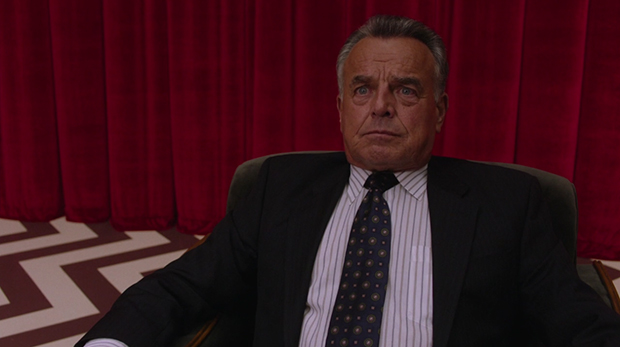
Leland
(18) Medium shot of Cooper. (19) Leland. (20) Cooper. Cooper turns, goes to somewhere around stage left, (21) then this time exits in a different manner. Instead of parting the curtains he appears to pass through a doubling of them that suddenly occurs there, a scratching sound occurring.

Doubled curtains
(22) Close-up of Cooper. (23) Indeed we now have a doubled effect of two rooms superimposed and slightly out of alignment. Does this mean two timelines?
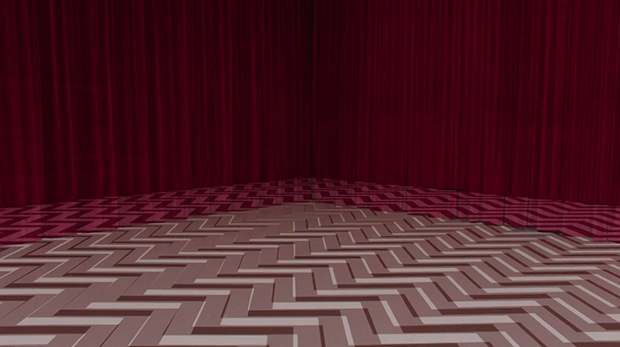
Red room doubled
The out-of-alignment increases, the corner area of one
of the rooms independently moving and approaching Cooper from his point
of view.
(24) Close-up of Cooper.
(25) Cut to Gerard with The Tree as the Arm.
(26) Cut to the Venus of the Hall,
which we had not seen previously in this scene. A scratching noise as
the camera zooms in on her. This Venus is different from the one in the
room with the seating, known as the Venus of Arles, and may be a copy of
the Aphrodite of Thespiae by the same sculptor, Praxiteles, who did the
Capitolene Venus. Though the head is shown as fixed to the sculpture,
this is a partial restoration. When discovered, the statue was missing
its right arm, its left arm from below the left elbow, and the right
hip. The head was dissociated but clearly belonged to the sculpture,
touching at one point. Fully restored, she was given symbols belonging
to her, bearing an apple in her right hand and a mirror in her
left.
Knowing that this Venus was found in fragments, its head
separated from the torso, may or may not connect with the Experiment
with its peculiar head. This may or may not connect to the theme of the
head dissociated from the body. One wonders if there is a connection with the one-armed man and The Arm, though Gerard misses his left arm and the Venus misses her full right arm. But there is certainly a reason for
there being two statues of the Venus, rather than one.

Venus in the hall
(27) Return to Gerard with
The Tree as the Arm. GERARD: Something's
wrong.
(28) THE TREE AS THE ARM: My doppelganger.
The arm's doppelganger? We've been informed of the
evolution of the arm. But a doppelganger?
(29) A view of the corner of the Red Room and
Cooper crossing the floor from screen right to upper screen left
(towards the center of the screen) and passing through the
drapes.
(30) He exits from screen
left into the corridor, the camera now facing the Venus. (31) Cooper. (32) A
mechanical whooshing sound. Again, the camera zooms in on the Venus.
(33) Cooper approaches the statue and (34) as he goes down the hall
(35) the sound halts. Before the hall's Venus, he parts the curtains
at screen right (36) and looks out over a
desert road. We see Mr. C's car driving down it.
(37) Cooper watches from the corridor.
Presumably, C is driving down a road in South Dakota though I can tell you, based on the foliage, that's not the case. This is southwest scenery, but I am going to assume this is supposed to be South Dakota.
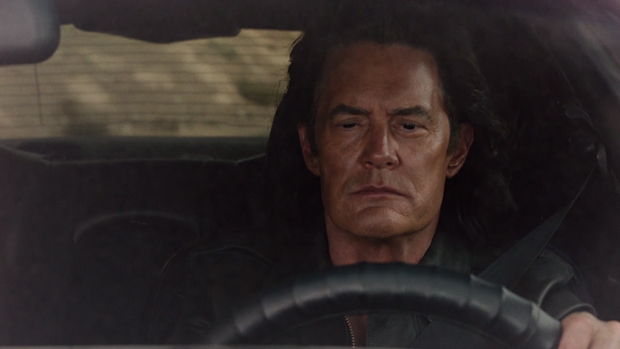
C driving
We know that now Cooper and his doppel are supposed to exchange places. The viewer wonders how this will work. We had expected that exchange likely to happen by means of Glastonbury Grove's entrance to the Red Room and the Black Lodge. But the doppel in the Black Hills, so can the exchange instead happen here. We see on the highway a sign that shows a man riding a horse and might be reminded of the white horse that was in Sarah's visions and which Cooper had seen after Laura had been snatched, screaming from the Red Room.
(38) A view of the doppel
driving. He looks at his watch. (39) Cooper.
(40)The doppel.
(41) Cooper. (42) As the car appears
to pass under the area where Cooper stands,
(43) the Venus disappears, (44)The
Tree as the Arm appearing in its place only the fleshy pod now has a
yellow cast. Intense rumbling. (45) Cooper
stands back in amazement. (46) The tree.
(47) Cooper.
(48)The tree violently shakes, (49)
the floor quakes under Cooper, (50) Cooper
stares down at it, (51) its zig-zag lines
separating. (52) The tree. (53) Cooper. (54)The
tree. (55) Cooper.
(56)The floor. (57) Cooper. (58) The floor parts (59)
as the Tree as The Arm exclaims, Non-existant!" (60) and
Cooper drops (61) into what appears to be
water.
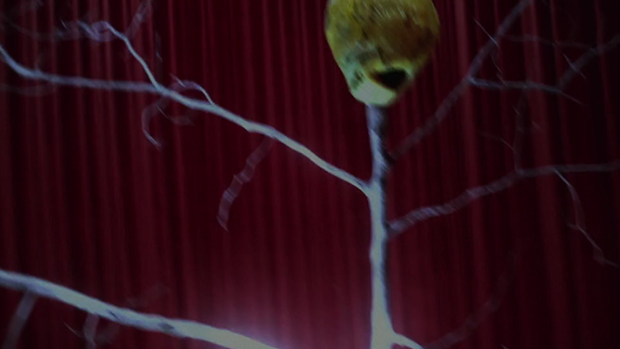
The Tree as the Arm Replacing the
Venus
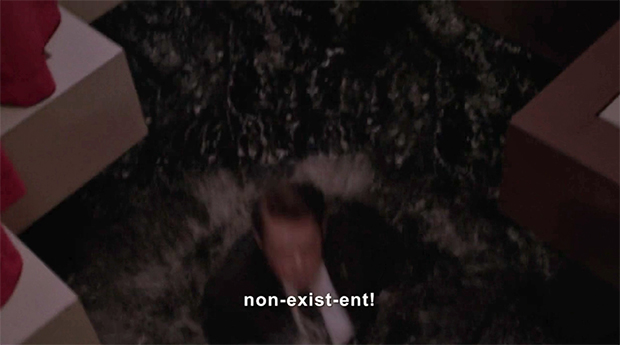
Cooper plunges into the "waters"
With the return to the Red Room we see Leland, who
appears not to be a doppelganger (we were shown a doppelganger of
Leland's at the end of the original series) and he says something
peculiar, that he wants Cooper to find Laura. At least that is what he
appears to say. We can only reason this has to do with Laura's being
swept, screaming, from the room, earlier.
We are given the
number 2-5-3, and viewers will be now be looking for this.
We need to
consider the one-armed Venus in the hall and her relationship to the
one-armed man, her right arm missing as opposed to her left, and
her relationship to The Tree as Arm as the statue is replaced by it. Or
is the statue replaced with The Tree as Arm's doppelganger, the
replacement having a yellow tint? There are two Venuses in the lodge. Should we consider one a doppleganger of the other? Is this Venus in the hall, in Lynch land, considered to be the dopple of the one in the room with the armchairs?
We must wonder what The Tree
as the Arm (or its doppelganger) means when it cries out,
"Non-existant!" Is it referring to Cooper? Jeffries was stated to be
"nowhere". So what would it mean for Cooper to be non-existant when, as
far as we can tell, he still exists after plunging through the floor. To
begin to understand what is going on here we need to comprehend that
Lynch is perhaps exploring the meaning of existence, such as the problem of inherent existence, which I will approach at the end of this part of the
analysis.
COOPER FALLS INTO THE GLASS BOX
REPEAT OF TRACEY AND SAM IN NEW YORK / THE MISALIGNMENT OF WINDOWS IN A NEIGHBORING BUILDING PERHAPS CONNECTED WITH THE IDEA OF DOUBLING SHOWN BY A MISALIGNMENT, SUCH AS THE DOUBLING AND MISALIGNMENT WE HAD OBSERVED IN THE RED ROOM / THE GLASS BOX ENVISIONED AS AN EYE IN THIS SCENE / THE ZIGZAGS ON THE FLOOR OF THE RED ROOM AND THE WATERFALL -- COMPARING THIS SCENE TO HENRY'S DREAM In ERASERHEAD / THE STARRY EFFECT COMPARED TO THE PARTICULATES OF HENRY'S BRAIN
(1) 45:25. We view Cooper from above as he falls through what appear to be stars, white specks in black.
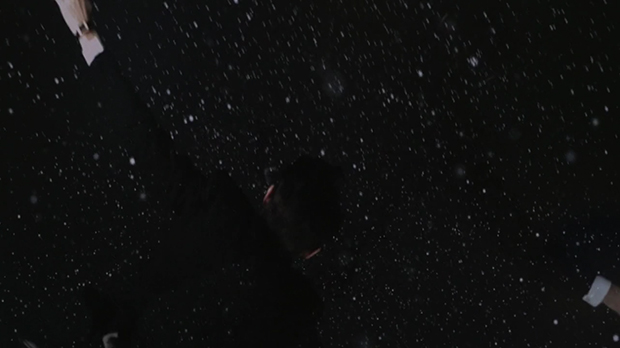
Falling as through stars
(2) He lands on the glass box in New York, a part exterior the building.
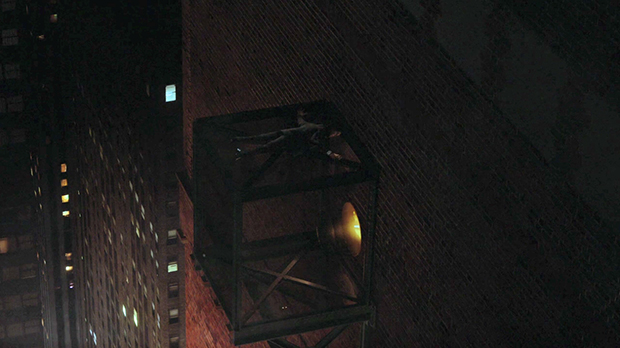
Cooper on the exterior glass box
(3) A lshot of him on the box. (4) He passes through the glass box to its interior, (5) and then from outside the building he passes through the lens into the interior, still within the box, floating. Gravity doesn't apply within the box. (6) He gazes around the empty room. (7) A view of Cooper in the box. (8) He looks to the open door.
(9) A view of the desk of the absent guard. We hear a door opening.
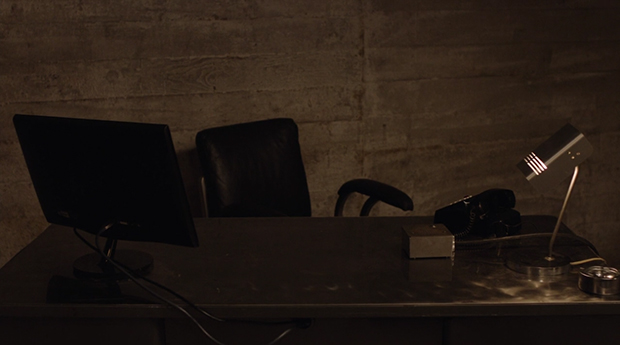
No guard
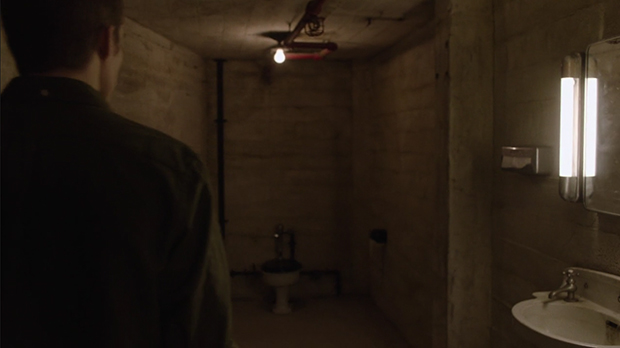
The empty bathroom
(10) We see Sam entering the
bathroom looking for the guard as he had done the previous Thursday.
(11) We see Tracey.
(12) Sam returns to her and says, "Weird. Where
is he?" (13) She asks, "Does this by any chance mean that I can go in there with
you? I brought us two lattes again."
We are seeing that Cooper had appeared in the box when Sam left the room and had found there was no guard.
(14) Return to Cooper in the glass box (15) he looking out on the room, and the lens and
the frame around it seem to form an eye around him.
(16) The glass box shakes. (17)
Another view of Cooper in the "eye". (18)
Cooper in the box. (19) A long shot as the
box begins to sandwich him back accordion style with loud bangs as the
box appears to be duplicating itself over and over again, Cooper and
the portal receding from us. This happens about 9 times. Then Cooper is
brought back forward 4 times, then recedes, comes back forward,
recedes, comes back forward fully, then recedes back about 10 times and
he disappears.
There is a whooshing sound,
(20) a bright flash of light, (21)
and then we see the box returned to its normal state. When Tracey and Sam enter they wil have no idea that they missed out on seeing Cooper.

Cooper leaves the box
(22) Cooper falls again through the white-speckled black, (23) face to the camera. (24) Then face away from the camera. (25) Face to the camera. (26) Face away from the camera. (27) Face to the camera.
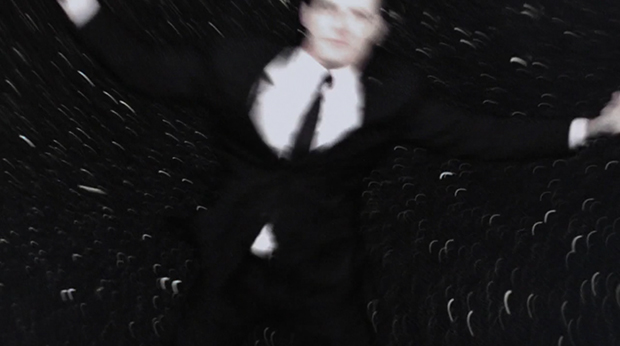
Cooper Falling
Is this a surprise? I know it's all a surprise to me. I never try to anticipate what Lynch/Frost will do.
When he is
looking out upon Mr. C driving the car it would
be the day after the murders of Jack and Darya, however he then enters the
glass box in New York when the security guard has disappeared and Sam
and Tracey are wondering what is going on so it is the day that they are
killed. Unless the segments are wildly out of order, he has fallen back in time.
The glass box seems to undergo a process of
self-replication while Cooper is in it, as we can see from the lights
and the frame, and Cooper is eventually ejected. This may fit in with
the Red Room seeming to have doubled not long before Cooper dropped
through the hall floor and into the day Sam and Darya are
killed.
The viewer is left stunned. They could never have anticipated that Cooper would fall into the glass box in New York after watching Mr. C driving through the desert. They are left to wonder if the glass box was designed to interfere with his return from the Red Room? What would have happened had Cooper been in the glass box when the Experiment appeared? Was the Experiment instead pursuing Cooper and they had missed one another? This carries in it an echo of the false "Jeffries" saying he had missed Mr. C in New York, no date given. Was the Experiment's entry into the box a result of Cooper's having passed through the box? Were Sam and Tracey attacked only because Cooper happened to not be there?
Remember Sam's glitch. He had been changing the SD card on the left, then was shown to be changing the SD card on the right camera 3, then was instead shown again to be changing the SD card in the left camera. Did that glitch have anything to do with things going "wrong" in the Red Room? With The Arm's doppelganger? Does that glitch have anything to do with Cooper finding the Red Room is doubled itself, out-of-alignment, and he passes out of the curtain in a different way from normal?
Let's return to the long shot of Cooper when he's landed on the glass box and is still outside the building. One has to wonder, storytelling-wise, why Cooper must land on the exterior rather than be captured within the building. As I look at the long shot of Cooper lying on the glass box, my eye is drawn to a high window in the next building that is strongly illuminated in comparison with the other windows in the building. It is then that I notice the windows facing the viewer, on that building, are out of alignment with the windows facing screen-left. This hardly seems like a mistake that would have been made in CGI fabrication of the scene, they should be meticulous, so are we to assume this is intentional and represents also a doubling made noticeable by misalignment, or a superimposition of two timelines, as perhaps had begun to be shown with the two Red Rooms, and it is due this misalignment (or whatever is occurring) that the security guard is missing? The misalignment may play in with how the box behaves before Cooper is ejected from it, reduplicating itself numerous times but each time slightly misaligned so that no box is perfectly juxtaposed, the glass boxes are instead all nested within one another, yet there is no change in size.
The zigzags of the floor opening and Cooper dropping into what appears to
be water, and then falling through the glass of the box, takes us back
to Eraserhead and the final episode of the original series. At
the end of the season two, between when Cooper's doppelganger
catches up to him in the Red Room and Harry Truman sees that the Cooper
doppelganger returned, Lynch gives us a transitional daytime shot of the
waterfall even though it is night. As I had mentioned earlier, the shot
of the waterfall in the opening, its twin streams parting and converging
again, is significant. We see in the below shot of the falls, from that
last episode, that Lynch is drawing a parallel between the zigzag floor
and the water of the falls which seem to exhibit a zigzag effect. What
is not seen in the below screengrab is how the falls are parting and
merging.
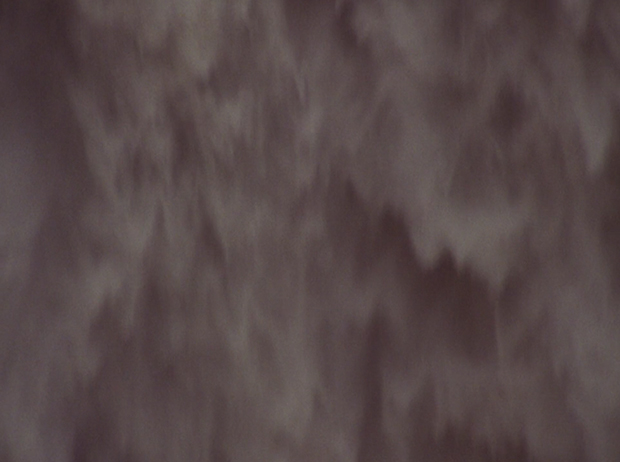
The falls
In Eraserhead, after Henry's head pops off and rests in the black liquid that flows from the tree's base, the head suddenly passes through the liquid and the black-and-white tile floor, falling out of the theater atmosphere of the dream into the "real" world (though Henry is still dreaming).
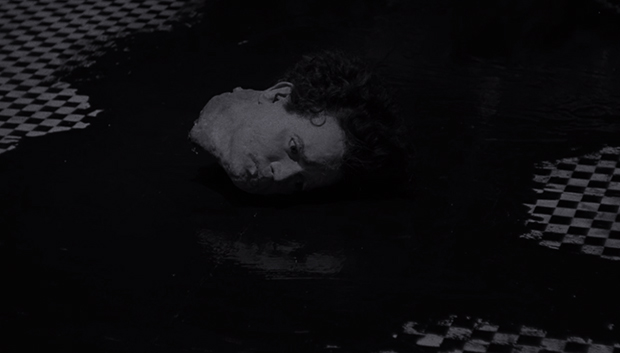
The Head
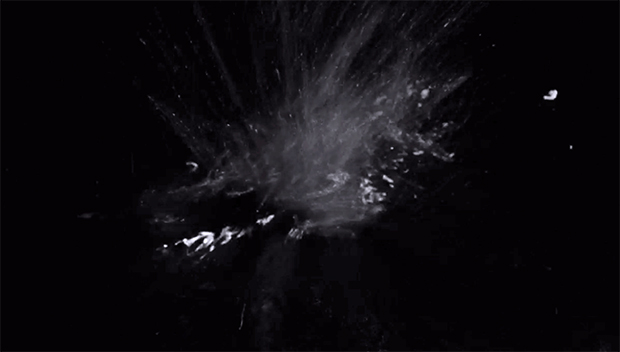
The Head
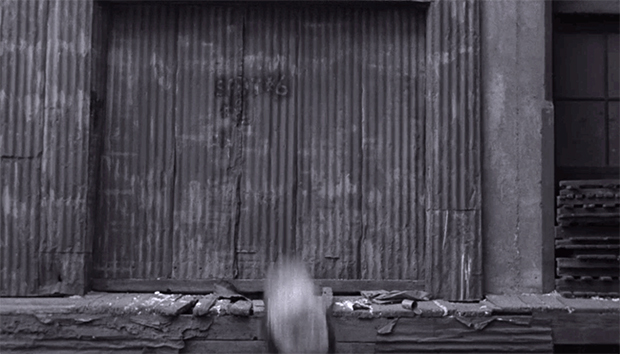
The Head
The head comes to rest on the street before a drunk, sleeping vagrant. The vagrant wakes to see a boy run and pick up the head and carry it away. The boy takes the head to a place where its brain is used for making pencil erasers. What is most hauntingly significant is that, after the brain-eraser is used to erase a pencil mark, its particles are swept away, off the paper, and those particulates, starry white against black, are to be compared to the particulates that fly from a peculiar rocky-planet-egg in which a hole explodes at the film's end, the particulates surrounding Henry. He then enters paradise after seemingly passing into the black hole of the planet-egg.

The Particles that are as the dust from the eraser
composed of Henry's dream brain
These eraserhead particulates, formed of Henry's dream brain, are to be compared with the "stars" through which Cooper falls when he tumbles between the zigzags of the Red Room floor. In Eraserhead these particulates are brain matter. It is as if the cosmos is being compared to the brain, found within it, and vice versa. We could even look at Henry's hairstyle as reflecting the idea of him ever falling through these particulates.
SARAH PALMER
DIFFERENCE BETWEEN THE PALMER LIVING ROOM WHEN OBSERVED FROM THE INSIDE AS OPPOSED TO THE STREET VIEW, THE LIGHTS IN THE WINDOWS NOT THE SAME / THE DETRIUS OF A LIFETIME OF AGONY / MULTIPLE REFLECTIONS OF VIOLENCE / MEDITATION ON HUMAN VIOLENCE / THE RATIONALE OF THE KILLING OF THE WATER BUFFALO BEING FOLLOWED BY THE SCENE AT THE ROADHOUSE
(1) 47:56. Twin Peaks. Night. The exterior to the tragic Palmer household. The house appears dark except for a lamp in the lower right room.
(2) Inside we see Sarah Novack Palmer (Grace Zabriskie) watching a show (3) in which lionesses are attacking an African buffalo. We are in the living room (if viewed from outside, the screen left room on the first floor), but the arrangement of lamps in either of the two first floor rooms, observed from outside, is different from what we have here, no lamp directly before the window when we view the room from the inside. (4) Sarah watches from the sofa, smoking. The camera moves so we instead see the attack reflected in the mirrors behind and above Sarah, she intensely occupied with the violence on screen. (5) The show she watches is heavily cast with blue and the the red blood of the beast stands out vividly. (6) Sarah watches with increasing intensity. (7) The lions maul the buffalo.
Sarah, mother of Laura, was herself a "medium". Prior to
Laura's death she saw a white horse in the house. This happened again
prior Maddy's death. In the last episode of the original series, not
knowing what was going on with Cooper, she went to Major Briggs at the
diner and channeled a voice to him saying, "I'm in the Black Lodge with
Dale Cooper." The voice has been said to be that of Windom Earle's, which Briggs would recognize as Earle had kidnapped him as well at one point, but the voice didn't resemble Windom's at all, and one would wonder why Windom would want such a message conveyed to Major Briggs.
Due to Cooper falling back into Thursday, from Monday, it makes stating
the time of this scene with Sarah Palmer difficult. Due the nature of the death, the
violence of the mauling of the buffalo, I would suggest it is possibly
Thursday night and Sarah is tuning into the violence that has happened or is happening
in New York and Buckhorn, the murders of Sam and Tracey, and Briggs and Ruth Davenport. After all, we have just revisited the preliminaries to the scene in which Sam and Tracey are attacked by the Experiment after Cooper is seen to have fallen into the box and disappeared. Sarah, whose life has been visited by considerable violence, is clearly enthralled, captivated, and we may wonder if she has tapped into these murders.
This episode has been primarily concerned with happenings in Buckhorn, rather than introducing old characters. The new viewer doesn't need to know much about Twin Peaks when there is a focus on Buckhorn, though they would have wondered who Jeffries was. A new viewer might be able to make the connection between the storyline of Cooper preparing to leave The Red Room, his doppel having to come back in first, and the doppel saying he has a plan to keep from being pulled back into the Black Lodge. As for the seasoned viewer, this is what they have been awaiting for over twenty-five years, for Cooper to return.
Seeing the Palmer residence and Sarah again would also be hotly anticipated by the returning viewer. The living room is different from but much the same as in Fire Walk with Me. And Sarah? In real life, we would wonder why she would remain in the house where her daughter was murdered by her husband, where her niece was murdered by her husband, where her husband had abused Laura for years--but here she is, and she looks fractured. This is a woman who has endured hell and chosen to live surrounded by memories.
The close-up shot of the television is actually not one continuous shot of the lions attacking the buffalo. Instead, it is three shots that are so similar they might be mistaken to be one.
The Chromatics' "Shadow" begins to play. We next go to the Roadhouse. A kind of rationale for this transition from Sarah Palmer to the Roadhouse can be found for this in Blue Velvet. The Slow Room bar in Blue Velvet had a number of antler racks ornamenting its roof, and inside, at the foot of the stage, was a pair of horns from a Longhorn. These were intended to relate visually to the vicious-looking mandibles of the stag beetles seen hidden in the grass of the lawn at the beginning of the film. Though these horns were forceful in appearance, as we can see with Sarah Palmer the water buffalo, despite its horns, proves to be no match for the lionesses.
THE BANG BANG BAR
COLONIAL BEER AND THE LIONS / CHROME VISION
(1) The exterior of the Bang Bang Bar. (2) A close-up of the sign. (3) Then cut to show the singer. (4) The audience. (5) Close-up of the singer. (6) The audience.

The Bang Bang
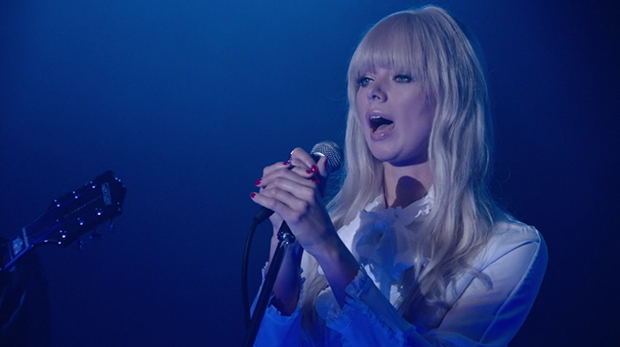
The Chromatics singer
Shadow
Take me down
Shadow
Take me down with you
For the last time
for the last time
for the last time
You're in the water...
(7) We see women downing
shots at a booth. (8) The band. (9) The singer. (10) The
singer. (11) On "You're in the water", James Hurley enters with a new character, Freddie
Sykes (Jake Wardle). For some reason, Freddie wears a green glove on his right hand. I don't know if this should take us back to Dave's interaction with the coroner and her praising him for being "good" when he is wearing his gloves. "Great
place isn't it," James says. Freddie replies, "Yeah, it's the dog's bollocks in here." James asks
him what kind of beer he wants and the other man says he'll have
whatever. James orders two ice-cold Colonials. Why Colonial beer? Is it because the logo of the Colonial Brewing Company shows two lions to either side of a seven-pointed star? Do the Colonial lions link back to the lionesses on Sarah's television set?
(12) Cut to Shelly Johnson in a booth with
three other unknown women. She tells them, "No, you guys, my
daughter is with the wrong guy." The woman sitting next to her
in the booth says, "Are you kidding me? Everybody
loves Steven." Shelly responds, "You don't
know Becky. I can see it on her face. There is something really
wrong." Hannah (Gia Carides), sitting across from them, says,
"It's her life."
(13) Cut again to
James.
Can you hear me, can you hear me
James has noticed Shelly's booth and stops and stares. (14) The women in the booth. (15) James watching. (16) Hannah says to the woman sitting next to Shelly, Renee (Jessica Szohr), "Hey, over there. There's James. He's staring at you again." (17) James sees he has been noticed and looks away. (18) Shelly asks if James has a thing for her, to which Hannah says, "There's something wrong with that guy." Shelly informs, "There's nothing wrong with him. James was in a motorcycle accident. He's just quiet now." (19) Shot of James. (20) Shelley. SHELLY: James is still cool. He's always been cool.
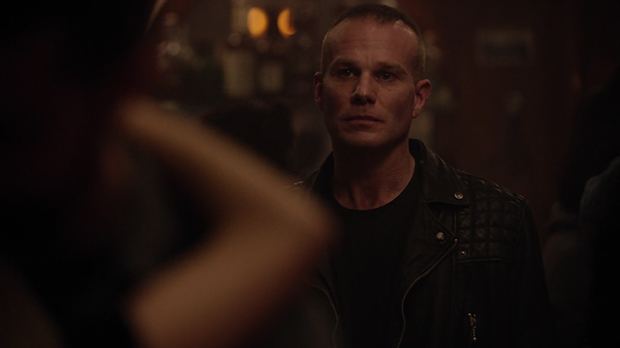
James Hurley
(21) Shot of James and Freddie. (22) The band. (23) Red (Balthazar Getty), a new and as yet unidentified character, stands over by the bar in front of a man who appears to be Jacques Renault (Walter Olkewicz as Jean-Michel Renault), is noticed by (24) Shelly, who watches him. (25) He sees her and makes eye contact. (26) She smiles at him and (27) he points his hand at her in mimicry of a gun and firing it. (28) Cut to Shelly again, still smiling. (29) Red. (30) The band and etcetera as the band continues.

Bang
At night I'm driving in your car
Pretending that we'll leave this town
We're watching all the street lights fade
And now you're just a stranger's dream.
I took your picture from the frame
And now you're nothing like you seem
Your shadow fell like last night's rain
For the last time
For the last time
For the last time.
The audience will be confused because here is a man
bartending who appears to be Jacques Renault, then they learn in the
credits it's Jean-Michael Renault. Jacques Renault led a double life as
bartender at the Roadhouse (Bang Bang) and a croupier and dealer at One
Eyed Jack's. He engaged in abusive sex with Laura the night she was
killed, but was knocked out before her murder. He was arrested for the
murder of Laura Palmer and the attempted murder of Ronette Pulaski. When he threatened Harry Truman's life, he was shot
in the arm by Andy Brennan. While sleeping in the
hospital after being shot, Jacques was smothered to death with a pillow by Leland Palmer, who would say he killed him because he believed he was killing Laura's murderer. Jacques
had a brother, Jean Renault, played by Michael Parks. Just how the previously unknown
Jean-Michael Renault is related is unknown, but it's curious as he becomes in effect a doppelganger/twin of Jacques.
James Hurley was
Laura's secret good-guy biker boyfriend at the time she was killed, thereafter becoming
the boyfriend of her friend, Donna. He later left town. Laura described him as sweet but dumb--and he truly wasn't known for being bright. In the "meanwhile", we find that he had a motorcycle accident and is now considered by some to be creepy. Perhaps he sustained some brain damage.
Shelly
Johnson, a waitress at the Double R Diner, was the wife and punching bag
of bad boy Leo (another lion) Johnson. She was also having a relationship with Bobby
Briggs, Laura's boyfriend. In the "meanwhile" we now learn she's had a daughter. We
don't know who the father is. As Shelly was in an abusive relationship
in the past, it is worrisome the manner in which the man at the bar
relates to her, taking aim at her in too serious a manner, and she
responding as she does to his bad boyness. If they are in a relationship, we wonder why it seems to be veiled in secrecy, Shelly seeming to keep this from her friends.
We will want to look at the lyrics to the Chromatics song and see how they intersect with the movie, but that can be difficult due their open-endness, so no doubt many different interpretations can be had. What we can do is examine their name. In the scene of meeting above the convenience store, in Fire Walk with Me, which Jeffries said he had witnessed, an extended version in the script gives the following:
FIRST WOODSMAN (subtitled): We have descended from pure air.
MAN FROM ANOTHER PLACE (subtitled): Going up and down. Intercourse between the two worlds.
BOB (subtitled): Light of new discoveries.
MRS. TREMOND (subtitled): Why not be composed of materials and combinations of atoms?
MRS. TREMOND'S GRANDSON (subtitled): This is no accident.
MAN FROM ANOTHER PLACE (subtitled): This is a Formica table. Green is its color.
FIRST WOODSMAN (subtitled): Our world.
MAN FROM ANOTHER PLACE (subtitled): With chrome. And everything will proceed cyclically.
SECOND WOODSMAN (subtitled): Boneless.
MIKE (subtitled): Yes, find the middle place.
BOB (subtitled): I have the fury of my momentum.
Our world. With chrome. Why with chrome? Perhaps because "chrome" is from the Greek khroma "color". A black and white world that progresses into color. I write more about this later and only wanted to note that conversation here due the Chromatics, James' friend wearing a green glove on his right hand, and it being said that James is quiet now because he had an accident. Green, no accident, and chrome had been united in the above dialogue from Fire Walk With Me, and we also have, green, chrome, and an accident here. I've the feeling that the black/white world is something in the realm of Lynch's conception of the subatomic, of immaterial conceptions passing into materiality but I could be wrong.
At the end of the credits run, the episode is dedicated to Frank Silva who had played BOB.
On Being and Emptiness and Lynch and Metamorphosis
I have already shown how the "stars" through which
Cooper falls are as the particles of Henry's eraser-brain in
Eraserhead. Before Cooper experiences his fall, The Tree as the
Arm cries out, "Non-existent!" In respect of this seeming pronouncement
of erasure, we need to consider how already in Twin Peaks, The
Return one of the biggest problems is that of "naming" a person or
a thing. The doppelganger isn't the Cooper we know so we can't call him
Cooper. What do we call him? He is Cooper and yet he isn't. The Arm was
The Man From Another Place and now it is instead a sort of tree, and yet
The Man From Another Place was The Arm and The Arm remains the detached
left arm of Phillip Gerard. The Giant had become ??????? What is what and who is who with all the blendings and divisions that happen with these characters?
And what of Jeffries? Mr. C had identified him as being "nowhere", yet he believed he could still communicate with him. So "nowhere" did not mean obliteration as in the standard western conception of nothingness.
Thus we come to confronting the problem of inherent existence. Below is
a passage from some teachings of Lama Zopa Ripoche:
In reality, everything--all actions, agents, and phenomena--is merely labeled by mind. How all phenomena exist is by being merely labeled by the mind in dependence upon a valid base. Even the base is that which is merely labeled by mind in dependence upon another base. It goes on and on like that. Starting from the I and going down to the sub-atomic particles of your body, everything is merely labeled in dependence upon a base. Nothing else exists except that which is merely labeled by the mind. What phenomena are is that which is merely labeled by mind. Everything exists in mere name. All phenomena are only nominally existent.
Therefore, the I, action, and all phenomena are totally empty. They are totally non-existent right there from their own side. As much as possible, try to practice mindfulness of emptiness and dependent arising--that everything exists in mere name in dependence upon its base, which also exists in mere name in dependence upon its base.
Living your life with the mindfulness that things do not exist from their own side is the ultimate solution to death...The realization of emptiness frees you from the oceans of suffering of each realm. In addition, it ceases even the subtle obscurations, making it possible for this mind-stream to become enlightened.
In reality, phenomena exist merely nominally, by being merely labeled by mind. But your past ignorance projects upon them the appearance of inherent existence. There is not just the appearance of action, object, I, form, sound, smell, and so forth, but something extra-inherent existence; something real appearing from there. Due to past ignorance, this projection occurs, and then your present ignorance apprehends it as true.
The problem we are experiencing with naming Cooper and so many of Lynch's characters and things that we see ever
morphing (recall the portrait of Kafka at the Hastings house) has
probably everything to do with Lynch endeavoring to speak on labels that arise through the appearance of inherent existence.
The below is from "The
Emptiness Teachings" website and provides an example by means of
reflection on the nature of a bicycle:
Chandrakirti, a disciple of Nagarjuna, developed Sevenfold Reasoning to refute the belief in an inherently existent self and all other object phenomena. The Sevenfold Reasonings are listed and elaborated upon in the next section on the self and both deepens and broadens the argument that in order for any phenomena to inherently exist, it must either be exactly the same or different from the parts. If it was not, the object would instead and necessarily be designated in dependence upon parts rather than existing as an inherent unity, which is the emptiness position. Chandrakirti used a chariot in applying his Sevenfold Reasoning to phenomena, but the it can be applied to any object. A flower was used previously as an introductory example and now a bicycle will serve as another.
First, the felt sense of the bicycle as existing inherently needs to be identified. Imagine a bicycle and how it is taken to exist as a thing in itself, as if it has an inborn nature to be a bicycle, beyond and aside from its parts. This step is critical or the mistaken assumption will not be properly targeted. It takes a while to understand inherent existence because the assumption is so ingrained.
Second, the force of the sameness and difference argument also needs to be clear. If a bicycle is believed to exist inherently, this singular nature must either be identical to each of the bicycle's parts or altogether different from them. Otherwise, a bicycle could not be said to exist inherently or independently, but rather in dependence upon innumerable parts.
Third, the sense of the inherent nature of the bicycle must then be mentally compared to each part to determine whether it is either totally the same or different from them. Regarding sameness, is the unitary sense of the bicycle the same as each of the bicycle parts? Can you find a bicycle in the tire? Is a bicycle the same as metal? Is a bicycle the seat? Is it the color? Does the shape inherently make it a bicycle? Where is this essential bicycle nature to be found among these parts? The investigation must be thorough to be convincing, Next, if all of the different parts that are eliminated as not being that bicycle nature are put aside, is there a bicycle essence or nature left over, that still remains? Where is this bicycle nature that is supposed to own or collect the bicycle parts?
Then regarding difference, if there does exist a bicycle nature that is inherently different from the bicycle parts, what could a bicycle be and where is it? Aside from parts, what and where is a bicycle?
One comes to discover that an inherent existent flower cannot be found. It is not in the parts, or aside from them. Inherent existence doesn't exist, for nothing is partless but instead, dependently existent and therefore empty of own being. An inherently existent bicycle, flower, or a self of persons comes to be recognized as a conceptual overlay, a label, an illusion that appears to have independent status but does not.
Through analysis, when it is realized that an inherently existent bicycle or any phenomena cannot be found, the perception of an absence or void appears. During meditation, as the direct experience of emptiness fades, one returns to the analytic meditation, moving back and forth between insight and the direct perception of the object's absence, each strengthening the other. With continued practice and in applying this meditation to all different phenomena including processes such as cause and effect, motion and time, the realization of the emptiness of inherent existence deepens and becomes global and stable. Through emptiness meditation, insight and the direct apprehension of emptiness merge, come together it is said, "like water poured into water."
All of the questions concerning the bicycle can be
applied to the evolving Arm, as well as to Cooper and his doppelganger.
The Waiter is now as Otis but is also "one and the same" as The Giant,
so where is the "I"? The Giant is now ??????? so where is the "I"?
The doppelganger is Cooper and yet is not.
Where is the "I" of the Cooper that people expect? What is the "I" of
Bill or Phyllis Hastings when they can so radically morph into
other than what is expected of them? How
can Laura be dead and yet alive? How can she say she feels like she
knows Laura, then say she is Laura, say that she is dead but lives, and have
been also instead identified as a cousin? It is the problem of, "Aside
from parts, what and where is a bicycle?" It is the problem of the dead
Ruth Davenport's form, when the blanket is pulled back, being revealed
to not being completely Ruth Davenport.
If the concept of this "emptiness" is elusive, Lewis Richmond
describes it as follows:
The third century Indian Buddhist master Nagarjuna taught, "Emptiness wrongly grasped is like picking up a poisonous snake by the wrong end." In other words, we will be bitten!
Emptiness is not complete nothingness; it doesn't mean that nothing exists at all. This would be a nihilistic view contrary to common sense. What it does mean is that things do not exist the way our grasping self supposes they do. In his book on the Heart Sutra the Dalai Lama calls emptiness "the true nature of things and events," but in the same passage he warns us "to avoid the misapprehension that emptiness is an absolute reality or an independent truth." In other words, emptiness is not some kind of heaven or separate realm apart from this world and its woes.
The Heart Sutra says, "all phenomena in their own-being are empty." It doesn't say "all phenomena are empty." This distinction is vital. "Own-being" means separate independent existence. The passage means that nothing we see or hear (or are) stands alone; everything is a tentative expression of one seamless, ever-changing landscape. So though no individual person or thing has any permanent, fixed identity, everything taken together is what Thich Nhat Hanh calls "interbeing." This term embraces the positive aspect of emptiness as it is lived and acted by a person of wisdom--with its sense of connection, compassion and love....
Ari Goldfield, a Buddhist teacher at Wisdom Sun and translator of Stars of Wisdom, summarizes these two aspects as follows:
The first meaning of emptiness is called "emptiness of essence," which means that phenomena [that we experience] have no inherent nature by themselves." The second is called "emptiness in the context of Buddha Nature," which sees emptiness as endowed with qualities of awakened mind like wisdom, bliss, compassion, clarity, and courage. Ultimate reality is the union of both emptinesses.
If an inherent bicycle can not be found, then Hawk has his hands full with confronting Margaret's problem, posed by her log, that something is missing and it is up to him to find it.
STAB AT A TIMELINE
A timeline as best as can be reasoned on information
given thus far:
PART ONE:
1. Supernatural - B&W room
2. Jacoby's trailer,
day - Wednesday?
3. New York, Sam and Tracey, after 10 at night -
Wednesday
4. The Great Northern Lodge, Ben and Jerry, day -
Thursday
5. Twin Peaks Sheriff's Department, Lucy and the insurance
agent, day - Thursday
6. Buella's, night - Thursday
7. New York,
2nd night (we know this is certain) - Thursday
8. Buckhorn, South
Dakota, discovery of Ruth, day - Friday
9. Twin Peaks, Margaret
calls Hawk at work, night - Friday
10. Buckhorn, the coroner's, day
- Saturday
11. Buckhorn, Hastings taken into custody, day -
Saturday
12. Twin Peaks, Hawk, Lucy and Andy in the conference room,
day - Saturday. (Lucy wears the same clothes as in the scene with the
insurance salesman, but this scene and that one are separated by at
least one night in Twin Peaks. Hawk had spoken with Margaret at night, at
the office, but this scene is in daylight and so is another day.)
13. Buckhorn, Hastings interrogated - Saturday
14. Buckhorn,
Hastings home searched - Saturday
15. Supernatural - B&W room.
PART TWO
1. Buckhorn, Phyllis visits Bill in jail -- Saturday (Bill was picked up
on Saturday, presumably)
2. Buckhorn, Mr. C kills Phyllis --
Saturday night
3. Las Vegas, Duncan and Roger in Las Vegas, a woman
is given a job -- Saturday night
4. Buckhorn, Darya, Ray, Jack and
Mr. C eat at the motel's diner -- Saturday night
5. Twin Peaks, Hawk
visits Glastonbury Grove - Saturday night
6. Laura disappears from
the Red Room -- Undetermined time but perhaps equivalent to Saturday
night in real time
7. Buckhorn, Jack and Mr. C hide the Mercedes,
Ray lands in prison -- Sunday
8. Buckhorn, Jack and Darya killed by
Mr. C -- Sunday
9. Supernatural, Cooper looks out on Mr. C driving
the car -- Monday (as far as Mr. C goes)
10. New York, Cooper drops
into the New York box -- Fall back to NY Thursday
11. Twin Peaks,
Sarah Palmer watches television -- Undetermined time, can't be stated
with any confidence right now due to Cooper's slipping into Thursday and
then being swept out into space again. Perhaps Thursday.
12. Twin
Peaks, Shelly and James are seen at The Bang Bang -- Undetermined time,
can't be stated with any confidence right now due to Cooper's slipping
into Thursday and then being swept out into space again. Perhaps
Thursday.
Approx 23,500 words or 47 single-spaced pages. A 180 minute read at 130 wpm.
Prior: Go to Part 1
Next: Go to Part 3
Go to Table of Contents for Analysis of Twin Peaks Return
Link to the main TOC page for all the analyses

